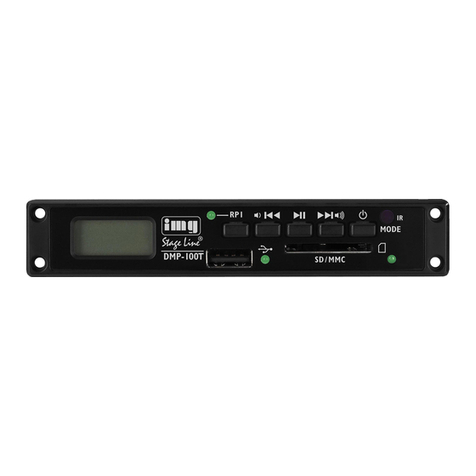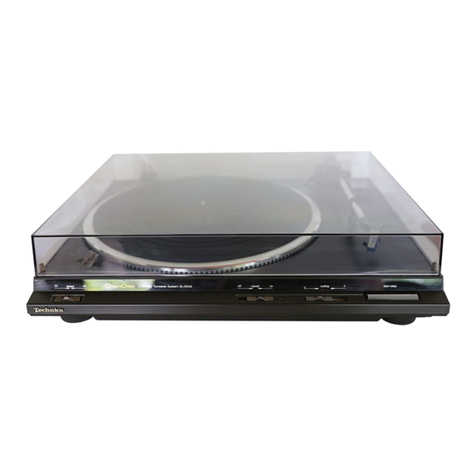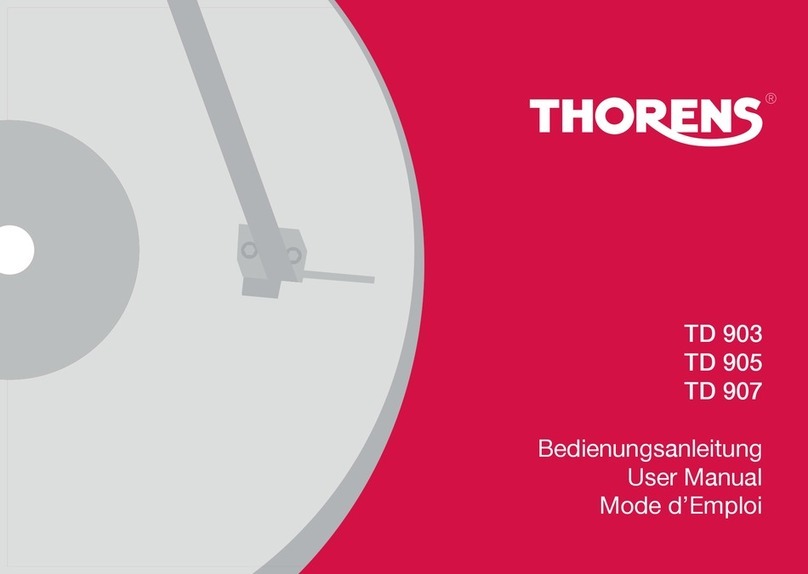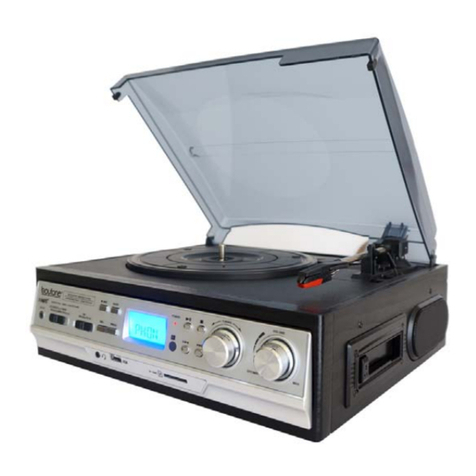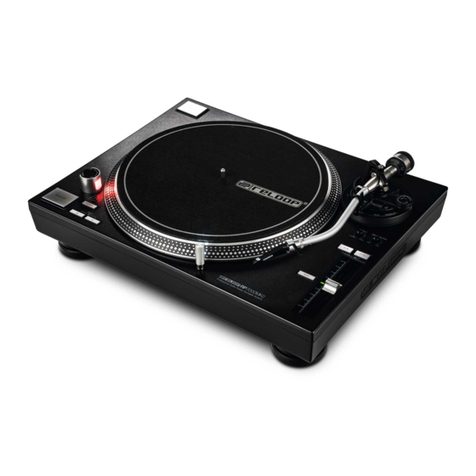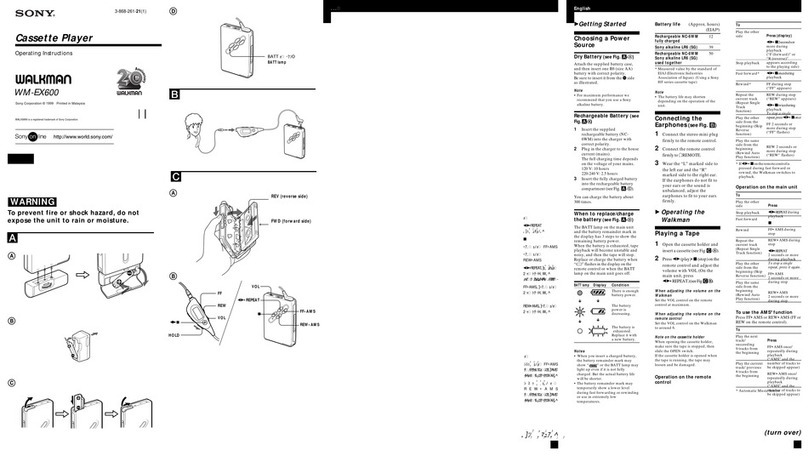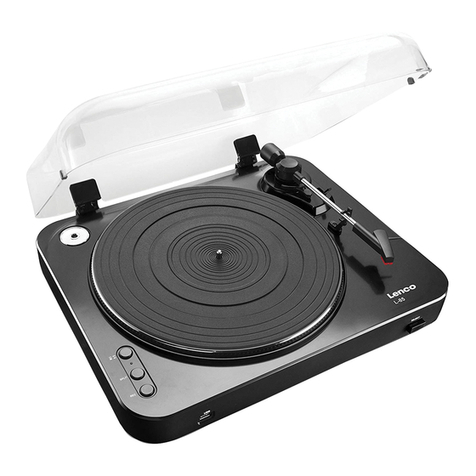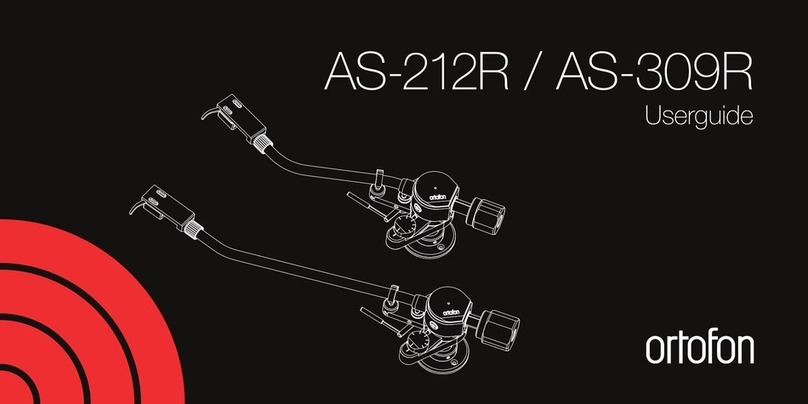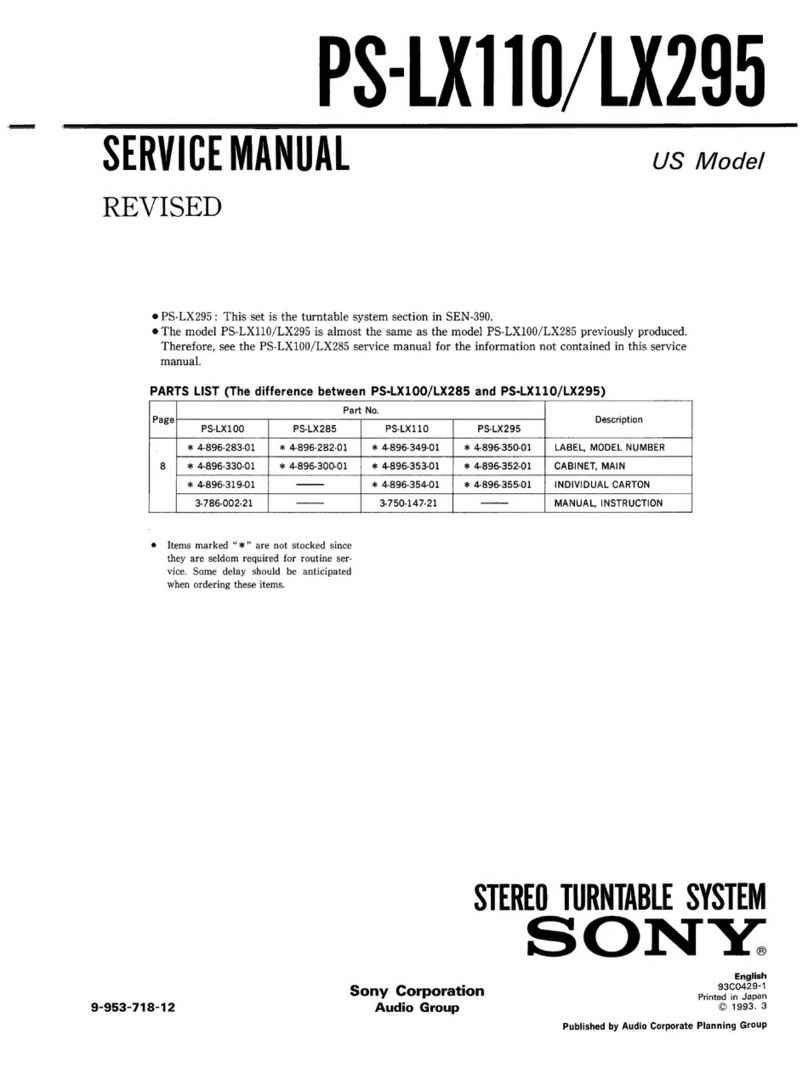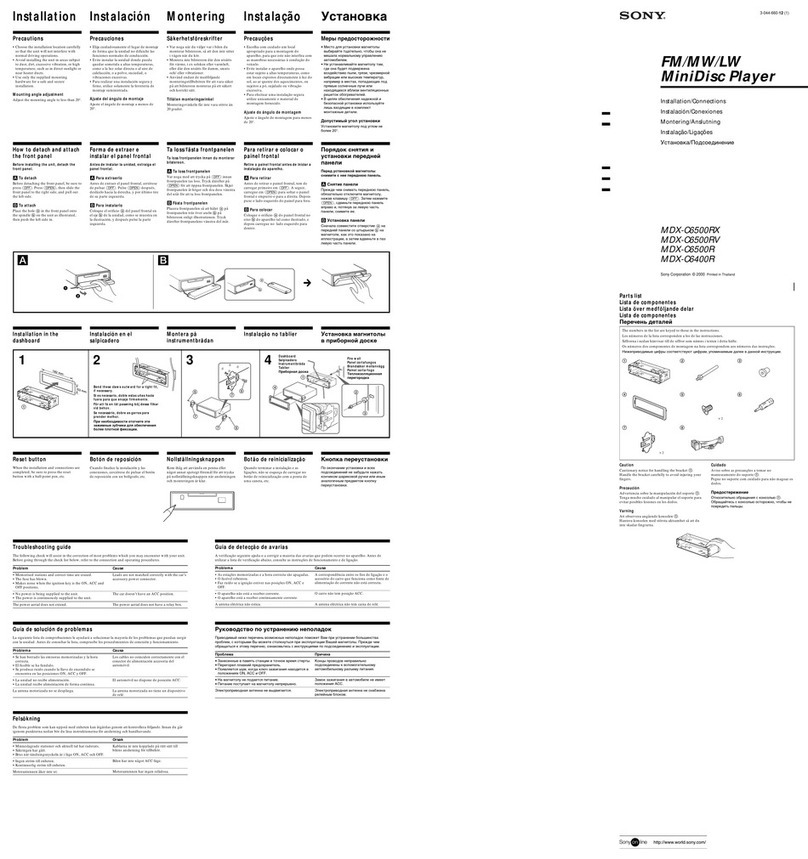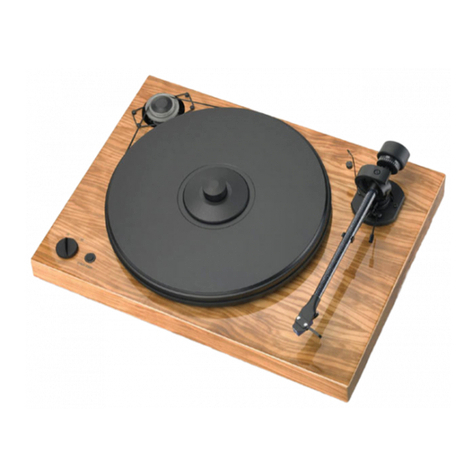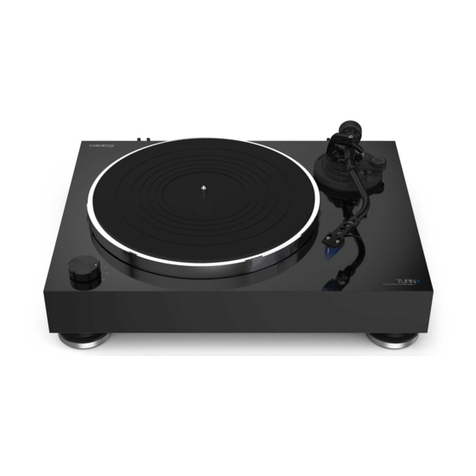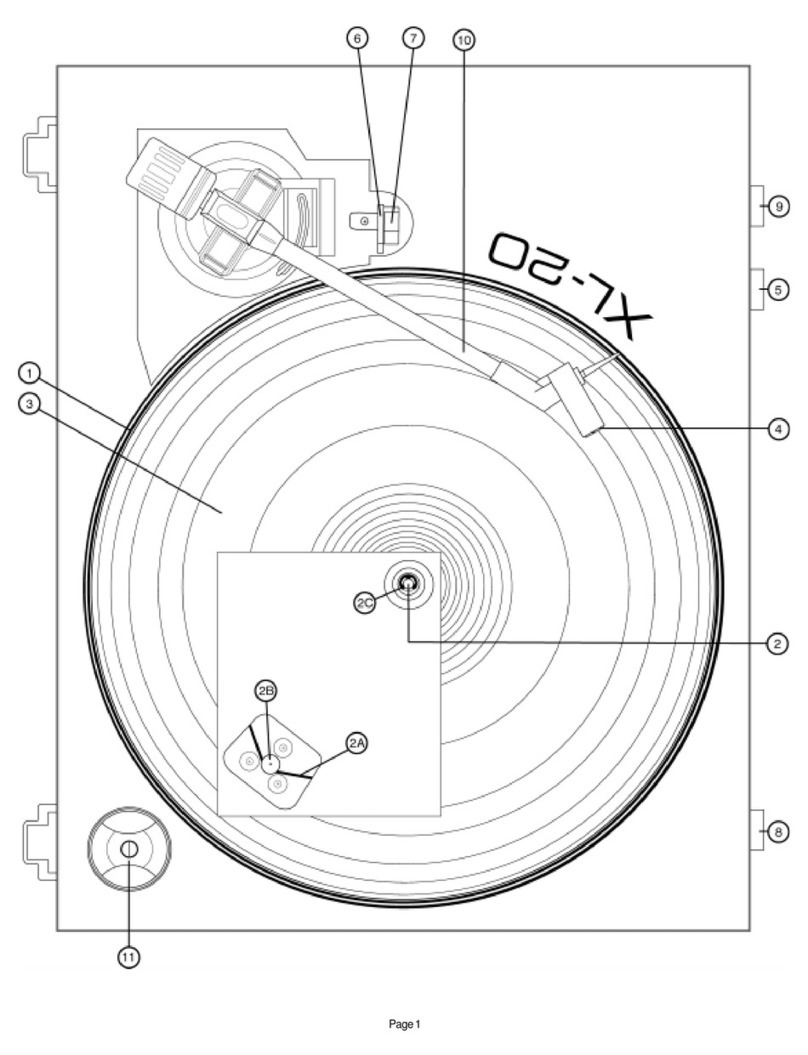IMG STAGE LINE DJP-104P User manual

DJ-HIFI-PLATTENSPIELER
DJ HIFI TURNTABLE
PLATINE-DISQUES HIFI POUR DJ
GIRADISCHI HIFI PER DJ
DJP-104P Best.-Nr. 21.1970
BEDIENUNGSANLEITUNG • INSTRUCTION MANUAL • MODE D’EMPLOI
ISTRUZIONI PER L’USO • GEBRUIKSAANWIJZING • MANUAL DE INSTRUCCIONES • INSTRUKCJA OBSŁUGI
SIKKERHEDSOPLYSNINGER • SÄKERHETSFÖRESKRIFTER • TURVALLISUUDESTA

2
Bevor Sie einschalten ...
Wir wünschen Ihnen viel Spaß mit Ihrem neuen Gerät von
„img Stage Line“. Dabei soll Ihnen diese Bedienungsan-
leitung helfen, alle Funktionsmöglichkeiten kennen zu ler-
nen. Die Beachtung der Anleitung vermeidet außerdem
Fehlbedienungen und schützt Sie und Ihr Gerät vor even-
tuellen Schäden durch unsachgemäßen Gebrauch.
Den deutschen Text finden Sie auf den Seiten 4–6.
Before you switch on ...
We wish you much pleasure with your new “img Stage
Line” unit. With these operating instructions you will be
able to get to know all functions of the unit. By following
these instructions false operations will be avoided, and
possible damage to yourself and your unit due to im-
proper use will be prevented.
You will find the English text on the pages 4–6.
D
A
CH
GB
Przed uruchomieniem ...
Życzymy zadowolenia z nowego produktu “img Stage
Line”. Dzięki tej instrukcji obsługi będą Państwo w
stanie poznać wszystkie funkcje tego urządzenia.
Stosując się do instrukcji unikną Państwo błędów i
ewentualnego uszkodzenia urządzenia na skutek nie-
prawidłowego użytkowania.
Tekst polski znajduje się na stronach 14 – 15.
Voordat u inschakelt ...
Wij wensen u veel plezier met uw nieuw toestel van “img
Stage Line”. Met behulp van bijgaande gebruiksaan-
wijzing zal u alle functiemogelijkheden leren kennen.
Door deze instructies op te volgen zal een slechte wer-
king vermeden worden, en zal een eventueel letsel aan
uzelf en schade aan uw toestel tengevolge van onzorg-
vuldig gebruik worden voorkomen.
U vindt de nederlandstalige tekst op de pagina’s 10–12.
PL
B
NL Antes de cualquier instalación ...
Tenemos de agradecerle el haber adquirido un aparato
“img Stage Line” y le deseamos un agradable uso. Este
manual quiere ayudarle a conocer las multiples facetas
de este aparato. La observación de las instrucciones
evita operaciones erróneas y protege Vd. y vuestro apa-
rato contra todo daño posible por cualquier uso inade-
cuado.
La versión española se encuentra en las páginas 10–12.
Inden De tænder for apparatet ...
Vi ønsker Dem god fornøjelse med Deres nye “img
Stage Line” apparat. Læs oplysningerne for en sikker
brug af apparatet før ibrugtagning. Følg sikkerhedsop-
lysningerne for at undgå forkert betjening og for at be-
skytte Dem og Deres apparat mod skade på grund af for-
kert brug.
Sikkerhedsoplysningerne finder De på side 16.
E
DK
Förskrift
Vi önskar dig mycket nöje med din nya enhet från “img
Stage Line”. Läs gärna säkerhetsinstruktionerna innan
du använder enheten. Genom att följa säkerhetsinstruk-
tionerna kan många problem undvikas, vilket annars kan
skada enheten.
Du finner säkerhetsinstruktionerna på sidan 16.
SFIN
Avant toute mise en service ...
Nous vous remercions d’avoir choisi un appareil “img
Stage Line” et vous souhaitons beaucoup de plaisir à
l’utiliser. Cette notice a pour objectif de vous aider à
mieux connaître les multiples facettes de l’appareil. En
outre, en respectant les conseils donnés, vous éviterez
toute mauvaise manipulation de sorte que vous-même et
votre appareil soient protégés de tout dommage.
La version française se trouve pages 7–9.
Prima di accendere ...
Vi auguriamo buon divertimento con il Vostro nuovo
apparecchio “img Stage Line”. Le istruzioni per l’uso Vi
possono aiutare a conoscere tutte le possibili funzioni. E
rispettando quanto spiegato nelle istruzioni, evitate di
commettere degli errori, e così proteggete Voi stessi, ma
anche l’apparecchio, da eventuali rischi per uso impro-
prio.
Il testo italiano lo potete trovare alle pagine 7–9.
F
B
CH
I
Ennen virran kytkemistä ...
Toivomme, että uusi “img Stage Line”-laitteesi tuo sinulle
paljon iloa ja hyötyä. Ole hyvä ja lue käyttöohjeet ennen
laitteen käyttöönottoa. Luettuasi käyttöohjeet voit käyt-
tää laitetta turvallisesti ja vältyt laitteen väärinkäytöltä.
Käyttöohjeet löydät sivulta 16.
wwwwww..iimmggssttaaggeelliinnee..ccoomm

3
2.5
0
2
1.5
1
0.5
0
0.5
2.5
2
1.5
1
Tonarm ausbalancieren
Tone arm balance ➁Skalenring Auflagegewicht einstellen
Scale ring ➂Stylus pressure adjustment ➃
START/STOP
POWER
SPEED
33 45
-16
+16
0
PITCH ADJ.
DJP-104P
Belt Drive Turntable
A
N
T
I
-
S
K
A
T
I
N
G
3
2
1
0
➀
1
2
3
4
5
6
15
14
13
12
11
10
9
8
7

Please unfold page 3. Then you can always see
the operating elements and connections de-
scribed.
1Operating Elements and Connections
1Phono plugs for the stereo audio output (red =
right channel, white = left channel) for connec-
tion to the line level input of an amplifier or mixer
2Mains plug for connection to 230V~/50Hz
3Adapter for single records
4POWER switch
5Stroboscope lamp
6Start/Stop button
7Counterweight for the tone arm
8Rotary knob for the antiskating adjustment
9Lever for the tone arm lift
10 Tone arm locking lever
11 Tone arm
12 Sliding control PITCH ADJ. to change the pitch
(±16%)
13 Headshell with phono cartridge system
14 Button for the speed 45rpm
15 Button for the speed 331/3rpm
2Safety Notes
This unit corresponds to the directive for electro-
magnetic compatibility 89/336/EEC and to the low
voltage directive 73/23/EEC.
Please observe the following items in any case:
●The unit is suitable for indoor use only. Protect it
against dripping water and splash water, high air
humidity, and heat (admissible ambient tempera-
ture range 0–40°C).
●Do not place any vessels filled with liquid, e.g.
drinking glasses, on the unit.
●Do not operate the unit and immediately dis-
connect the plug from the mains socket
1. if there is visible damage to the unit or to the
mains cable.
2. if a defect might have occurred after the unit
was dropped or suffered a similar accident.
3. if malfunctions occur.
In any case the unit must be repaired by author-
ized personnel.
●Adamaged mains cable must only be replaced by
the manufacturer or authorized, specialized per-
sonnel.
●Never pull the mains cable to disconnect the
mains plug from the socket, always seize the plug.
●No guarantee claims for the unit and no liability for
any resulting personal damage or material dam-
age will be accepted if the unit is used for other
purposes than originally intended, if it is not cor-
rectly connected, operated, or not repaired in an
expert way.
●If the unit is to be put out of operation definitively,
take it to a local recycling plant for disposal which
is not harmful to the environment.
●Important for U.K. Customers!
The wires in this mains lead are coloured in
accordance with the following code:
blue = neutral
brown = live
As the colours of the wires in the mains lead of this
appliance may not correspond with the coloured
markings identifying the terminals in your plug,
proceed as follows:
1. The wire which is coloured blue must be con-
nected to the terminal in the plug which is
marked with the letter Nor coloured black.
2. The wire which is coloured brown must be con-
nected to the terminal which is marked with the
letter Lor coloured red.
3Assembly and Basic Settings
The headshell (13), the counterweight (7) for the
tone arm, and the dust cover are separately packed
to prevent damage to these parts and to the turnta-
ble during transportation. After unpacking all parts,
the packing material should be kept for a possible
transportation.
Place the turntable on an even, horizontal surface.
3.1 Mounting the headshell and the counter-
weight for the tone arm
1) Take the headshell (13) out of one of the two lat-
eral polystyrene wrappings, place it onto the front
end of the tone arm (11), and secure it with the
locking nut.
2) Take the counterweight (7) out of one of the two
lateral polystyrene wrappings and place it on the
rear end of the tone arm until it locks into place.
The counterweight is then used for precise
adjustment of the stylus pressure on the record.
3) Place the supplied felt slipmat on the turntable
platter.
3.2 Adjusting the stylus pressure
1) First turn the antiskating knob (8) counter-clock-
wise to “0”.
Attention!
The unit is supplied with dangerous mains voltage
(230V~). Leave servicing to authorized personnel
only. Inexpert handling may result in an electric
shock. Furthermore, any guarantee claim will ex-
pire if the unit has been opened.
4
GB
D
A
CH
Bitte klappen Sie die Seite 3 heraus. Sie sehen
dann immer die beschriebenen Bedienelemente
und Anschlüsse.
1Übersicht der Bedienelemente und
Anschlüsse
1Cinch-Stecker für den Stereo-Tonausgang (rot =
rechter Kanal, weiß = linker Kanal) zum An-
schluss an den Linepegel-Eingang eines Ver-
stärkers oder Mischpults
2Netzstecker zum Anschluss an 230V~/50Hz
3Adapter für Single-Platten
4Ein-/Ausschalter POWER
5Stroboskoplampe
6Start/Stopp-Taste
7Gegengewicht für den Tonarm
8Drehknopf für die Antiskating-Einstellung
9Hebel für den Tonarm-Lift
10 Verriegelungshebel für den Tonarm
11 Tonarm
12 Schieberegler PITCH ADJ. zum Ändern der Ge-
schwindigkeit (±16 %)
13 Systemträger mit Tonabnehmersystem
14 Taste für die Geschwindigkeit 45U/min
15 Taste für die Geschwindigkeit 331/3U/min
2Hinweise für den sicheren Gebrauch
Dieses Gerät entspricht der Richtlinie für elektro-
magnetische Verträglichkeit 89/336/EWG und der
Niederspannungsrichtlinie 73/23/EWG.
Beachten Sie auch unbedingt die folgenden Punkte:
●Das Gerät ist nur zur Verwendung im Innenbe-
reich geeignet. Schützen Sie es vor Tropf- und
Spritzwasser, hoher Luftfeuchtigkeit und Hitze
(zulässiger Einsatztemperaturbereich 0–40°C).
●Stellen Sie keine mit Flüssigkeit gefüllten Gefäße,
z.B. Trinkgläser, auf das Gerät.
●Nehmen Sie das Gerät nicht in Betrieb bzw. ziehen
Sie sofort den Netzstecker aus der Steckdose:
1. wenn sichtbare Schäden am Gerät oder an der
Netzanschlussleitung vorhanden sind,
2. wenn nach einem Sturz oder Ähnlichem der
Verdacht auf einen Defekt besteht,
3. wenn Funktionsstörungen auftreten.
Lassen Sie das Gerät in jedem Fall in einer Fach-
werkstatt reparieren.
●Eine beschädigte Netzanschlussleitung darf nur
durch den Hersteller oder eine autorisierte Fach-
werkstatt ersetzt werden.
●Ziehen Sie den Netzstecker nie am Kabel aus der
Steckdose, fassen Sie immer am Stecker an.
●Wird das Gerät zweckentfremdet, nicht richtig an-
geschlossen, falsch bedient oder nicht fachgerecht
repariert, kann keine Haftung für daraus resultie-
rende Sach- oder Personenschäden und keine
Garantie für das Gerät übernommen werden.
●Soll das Gerät endgültig aus dem Betrieb genom-
men werden, übergeben Sie es zur umweltge-
rechten Entsorgung einem örtlichen Recycling-
betrieb.
3Montage und Grundeinstellungen
Der Systemträger (13), das Gegengewicht (7) für
den Tonarm und die Abdeckhaube sind einzeln ver-
packt, damit sie und der Plattenspieler beim Trans-
port nicht beschädigt werden. Nach demAuspacken
aller Geräteteile sollte die Originalverpackung für
eventuelle spätere Transporte aufbewahrt werden.
Den Plattenspieler auf einer ebenen, waagerech-
ten Fläche aufstellen.
3.1 Systemträger und Gegengewicht für den
Tonarm montieren
1) Den Systemträger (13) aus einem der beiden
seitlichen Styropor-Verpackungsteile herausneh-
men, auf das vordere Ende des Tonarmes (11)
stecken und mit der Verriegelungsmutter sichern.
2) Das Gegengewicht (7) aus einem der beiden
seitlichen Styropor-Verpackungsteile herausneh-
men und auf das hintere Ende des Tonarmes ste-
cken, bis es einrastet. Mit dem Gegengewicht
wird anschließend das Auflagegewicht genau
eingestellt.
3) Die beiliegende Filzmatte auf den Plattenteller
legen.
3.2 Auflagegewicht einstellen
1) Zuerst den Antiskating-Drehknopf (8) entgegen
dem Uhrzeigersinn auf „0“ drehen.
2) Die Schutzkappe für die Abtastnadel nach unten
abziehen.
3) Den Hebel für den Tonarm-Lift (9) in die vordere
Position stellen.
4) Den Verriegelungshebel für den Tonarm (10)
nach rechts öffnen. Den Tonarm am Griff anfas-
sen und ihn vorsichtig bis kurz vor den Plattentel-
ler führen, so dass er sich frei nach oben und
unten bewegen lässt.
Vorsicht! Die Nadel nirgends anstoßen lassen.
5) Den Tonarm mit der linken Hand seitlich führen,
damit die Nadel nicht am Plattenteller anstößt.
Mit der rechten Hand das Gegengewicht (7) so
Achtung!
Das Gerät wird mit lebensgefährlicher Netzspan-
nung (230V~) versorgt. Nehmen Sie deshalb nie-
mals selbst Eingriffe im Gerät vor. Durch unsach-
gemäßes Vorgehen besteht die Gefahr eines
elektrischen Schlages. Außerdem erlischt beim
Öffnen des Gerätes jeglicher Garantieanspruch.

verdrehen, dass der Tonarm genau waagerecht
stehen bleibt und nicht nach oben oder unten
schwingt (Abb. 2).
–Schwingt der Tonarm nach oben: Gegenge-
wicht entgegen dem Uhrzeigersinn drehen.
–Schwingt der Tonarm nach unten: Gegenge-
wicht im Uhrzeigersinn drehen.
6) Den Tonarm zurück auf die Tonarm-Halterung le-
gen und mit dem Verriegelungshebel (10) sichern.
7) Am Gegengewicht befindet sich ein drehbarer,
schwarzer Ring mit einer Skala. Die rote Linie auf
dem Tonarm zeigt auf irgendeinen Wert der
Skala. Ohne dass das Gegengewicht verdreht
wird, nur den Ring auf „0“ drehen (Abb. 3).
8) Die Skala gibt das Auflagegewicht in Gramm an.
Für das mitgelieferte Abtastsystem ist ein Auf-
lagegewicht von 2g erforderlich. Dazu das Ge-
gengewicht (nicht den Ring mit der Skala allein!)
entgegen dem Uhrzeigersinn drehen, bis die rote
Linie des Tonarms auf „2“ zeigt (Abb. 4).
Für andere Abtastsysteme das Auflagege-
wicht einstellen, welches in den dazugehörigen
technischen Daten angegeben ist.
3.3 Antiskating einstellen
Beim Abspielen einer Schallplatte treten Kräfte an
der Abtastnadel auf, welche durch die Antiskating-
Einrichtung aufgehoben werden. Dazu den Anti-
skating-Drehknopf (8) von „0“ auf den Wert einstel-
len, der demAuflagegewicht gleich ist, d.h. bei dem
mitgelieferten Abtastsystem auf „2“. Der Wert ist
neben dem Pfeil auf dem Drehknopf abzulesen.
3.4 Abdeckhaube montieren
Die zwei Scharniere für die Abdeckhaube aus den
beiden Styropor-Verpackungsteilen herausnehmen
und auf die Abdeckhaube stecken. Die Abdeck-
haube mit den Scharnieren auf den Plattenspieler
aufsetzen. Sie kann jederzeit wieder abgenommen
werden, wenn sie beim Betrieb stört (z.B. beim
Disco-Betrieb).
4Plattenspieler anschließen
Vor dem Anschließen bzw. Ändern bestehender
Anschlüsse den Plattenspieler ausschalten.
1) Das Anschlusskabel mit den Cinch-Steckern (1)
– rot für den rechten Kanal, weiß für den linken
Kanal – mit den Line-Eingangsbuchsen z.B. am
Verstärker oder Mischpult verbinden; mögliche
Beschriftung „Line“, „CD“, „Tape“. Da der Platten-
spieler mit einem RIAA-Vorverstärker ausgestat-
ten ist, kann er nicht wie sonst üblich an Platten-
spielereingänge(„Phono“) angeschlossen werden.
2) Den Netzstecker (2) in eine Steckdose (230V~/
50Hz) stecken.
5Bedienung
5.1 Schallplatte abspielen
1) Die Schutzkappe für die Abtastnadel nach unten
abziehen.
2) Den Plattenspieler mit dem Schalter POWER (4)
einschalten. Die Stroboskoplampe (5) leuchtet.
3) Zur Wahl der Geschwindigkeit die entsprechende
Taste drücken:
für 331/3U/min die linke Taste „33“ (15)
für 45 U/min die rechte Taste „45“ (14)
Zur Anzeige der gewählten Geschwindigkeit
leuchtet die jeweilige LED über der Taste.
4) Die Schallplatte auflegen. Bei Single-Platten den
Adapter (3) mit auflegen.
5) Den Verriegelungshebel (10) für den Tonarm
nach rechts öffnen. Zum Anheben des Tonarms
den Hebel für den Tonarm-Lift (9) in die hintere
Position stellen.
6) Den Tonarm am Griff anfassen und die Abtast-
nadel über den Anfang bzw. die gewünschte
Stelle auf der Schallplatte positionieren. Den
Hebel für den Tonarm-Lift (9) in die vordere Posi-
tion stellen. Der Tonarm senkt sich langsam
auf die Schallplatte.
7) Die Start/Stopp-Taste (6) drücken. Der Platten-
teller beginnt zu rotieren.
Während des Abspielens kann die Platte für
eine Unterbrechung mit der Start/Stopp-Taste
an jeder Stelle gestoppt und wieder gestartet
werden.
8) Zum Beenden des Abspielens den Tonarm mit
dem Tonarm-Lift (9) anheben und ihn per Hand
auf den Tonarm-Halter zurückführen. Den Plat-
tenteller mit der Start/Stopp-Taste (6) stoppen.
9) Nach dem Gebrauch des Plattenspielers den
Tonarm mit dem Verriegelungshebel (10) sichern
und das Gerät mit dem Schalter POWER (4)
ausschalten. Die Abdeckhaube zum Schutz
gegen Staub herunterklappen.
5.2 Geschwindigkeit verändern
Bei Bedarf kann die Geschwindigkeit des Platten-
spielers und damit die Tonhöhe („pitch“) eines Titels
mit dem Regler PITCH ADJ. (12) um bis zu 16%
erhöht oder verringert werden. In der Mittelstellung
(Regler rastet ein) ist die gewählte Standardge-
schwindigkeit eingestellt, d.h. exakt 331/3U/min
bzw. 45U/min.
Zur Kontrolle der Geschwindigkeit 331/3U/min
dient der Stroboskopring am Plattentellerrand. Bei
rotierendem Plattenteller den Teil des Rings be-
trachten, der von der Stroboskoplampe (5) beleuch-
tet wird (eventuell die Raumbeleuchtung verringern):
–Bei einer Netzfrequenz von 50Hz bleiben die
Quadrate des unteren Rings scheinbar stehen
und bei einer Netzfrequenz von 60Hz die Recht-
ecke des oberen Rings, wenn die Geschwindig-
keit exakt 331/3U/min beträgt.
➄Stroboskopring bei 331/3U/min.
60Hz50Hz
2) Pull off the protective cover of the stylus in a
downward movement.
3) Place the lever for the tone arm lift (9) in the front
position .
4) Open the tone arm locking lever (10) to the right.
Seize the handle of the tone arm and lead it
carefully just before the turntable platter so that it
can freely be moved upwards and downwards.
Attention! The stylus must not hit against any-
thing.
5) Lead the tone arm with the left hand to the side
so that the stylus does not hit against the turnta-
ble platter. With the right hand turn the counter-
weight (7) so that the tone arm remains exactly in
a horizontal position and does not move upwards
or downwards (fig. 2).
–If the tone arm moves upwards: turn the coun-
terweight counter-clockwise.
–If the tone arm moves downwards: turn the
counterweight clockwise.
6) Put the tone arm back onto the tone arm support
and secure it with the locking lever (10).
7) The counterweight is provided with a black rotary
ring with a scale. The red line on the tone arm
points to a value on this scale. Without turning
the counterweight, only turn the ring to “0” (fig. 3).
8) The scale indicates the stylus pressure in grams.
Astylus pressure of 2g is required for the sup-
plied stylus system. For this purpose, turn the
counterweight (not only the ring with the scale!)
counter-clockwise until the red line on the tone
arm points to “2” (fig. 4).
Forother stylus systems, adjust the stylus pres-
sure indicated in the corresponding specifications.
3.3 Adjusting the antiskating facility
When playing a record, forces occur on the stylus
which are compensated by the antiskating facility.
For this purpose, adjust the antiskating knob (8)
from “0” to the value which equals the stylus pres-
sure, i.e. for the supplied stylus system to “2”: The
arrow next to the knob points to the corresponding
value on the knob.
3.4 Mounting the dust cover
Take the two hinges for the dust cover out of the two
polystyrene wrappings and attach them to the dust
cover. Place the dust cover with the hinges on the
turntable. It can be removed at any time if it interferes
with the operation (e.g. during disco operation).
4Connecting the Turntable
Prior to making any connections or changing any
existing connections, switch off the turntable.
1) Connect the cable with the phono plugs (1) – red
for the right channel, white for the left channel –
to the line input jacks e.g. at the amplifier or
mixer; possible lettering “Line”, “CD”, “Tape”. As
the turntable is equipped with an RIAA preampli-
fier, it is not possible to connect it to turntable
inputs (“phono”) as otherwise usual.
2) Connect the mains plug (2) to a mains socket
(230V~/50Hz).
5Operation
5.1 Playing a record
1) Pull off the protective cover of the stylus in a
downward movement.
2) Switch on the turntable with the switch POWER
(4). The stroboscope lamp (5) lights up.
3) To select the speed, press the corresponding but-
ton:
for 331/3rpm the left button “33” (15)
for 45rpm the right button “45” (14)
To indicate the selected speed, the respective
LED above the button lights up.
4) Put on the record. For single records, use the
adapter (3).
5) Open the locking lever (10) for the tone arm to
the right. To lift the tone arm, place the lever for
the tone arm lift (9) to the rear position .
6) Seize the handle of the tone arm, and place the
stylus above the beginning or the desired spot on
the record. Place the lever for the tone arm lift (9)
to the front position . The tone arm is slowly
lowered onto the record.
7) Press the Start/Stop button (6). The turntable
platter starts to rotate.
While playing, the record can be stopped at any
place and be restarted with the Start/Stop button.
8) To stop the playing, lift the tone arm with the tone
arm lift (9) and put it back onto the tone arm sup-
port by hand. Stop the turntable platter with the
Start/Stop button (6).
9) After use of the turntable, secure the tone arm
with the locking lever (10) and switch off the unit
with the POWER switch (4). Fold down the pro-
tective cover as a protection against dust.
5.2 Changing the speed
If required, the speed of the turntable and thus the
pitch of a title can be increased or reduced by up to
16% with the control PITCH ADJ. (12). In mid-posi-
tion (control locks into place) the selected standard
speed is adjusted, i.e. exactly 331/3rpm or 45rpm.
The stroboscope ring on the rim of the turntable
platter serves to check the speed of 331/3rpm. With
rotating turntable platter observe the part of the ring
which is illuminated by the stroboscope lamp (5) [if
necessary, reduce the room illumination]:
–With a mains frequency of 50Hz the squares of
the lower ring seem to stand still, with a mains
frequency of 60Hz the squares of the upper ring
seem to stand still if the speed is exactly
331/3rpm.
➄Stroboscope ring at 331/3rpm.
60Hz50Hz
5
GB
D
A
CH

6Zubehör
6.1 Ersatz-Tonabnehmersystem und -Nadel
Bei Bedarf kann das Tonabnehmersystem oder die
Abtastnadel leicht ausgewechselt werden. Im Fach-
handel sind entsprechende Ersatzteile erhältlich,
z.B. von „img Stage Line“ das Tonabnehmer-
Magnetsystem EN-24 und die dazu passende Ab-
tastnadel EN-24SP.
1) Zum Wechseln derAbtastnadel die orange Nadel-
halterung nach vorne abziehen. Die neue Nadel
auf das Abtastsystem stecken.
2) Zum Wechsel des Tonabnehmersystems den
Systemträger (13) vom Tonarm abschrauben.
3) Das Tonabnehmersystem vom Träger abschau-
ben und die Anschlussdrähte abziehen.
4) Das neue Tonabnehmersystem auf den Träger
festschraubenund die Drähte wie folgt aufstecken:
weiß linker Kanal Pluspol
blau linker Kanal Minuspol
rot rechter Kanal Pluspol
grün rechter Kanal Minuspol
5) Nach dem Austausch des Tonabnehmersystems
das Auflagegewicht und den Antiskating-Wert
neu einstellen (siehe Kap. 3.2 und 3.3).
6.2 Ersatz-Systemträger
Ein Ersatz-Systemträger (z.B. der Systemträger
EN-120 von „img Stage Line“) komplett mit einem
Tonabnehmersystem ermöglicht bei Bedarf einen
schnellen Austausch. Der Systemträger lässt sich
einfach durch Ab- und Anschrauben auswechseln.
Anschließend das Auflagegewicht und den Anti-
skating-Wert neu einstellen (siehe Kap. 3.2 und 3.3).
6.3 Filzmatte
Sollte die beiliegende Filzmatte einmal verlegt oder
verschlissen sein, kann eine neue Matte unter der
Bezeichnung DJP-1M von „img Stage Line“ bestellt
werden.
7Wartung
7.1 Pflege
Das Plattenspielergehäuse und die Abdeckhaube
nur mit einem trockenen, weichen Tuch oder einem
leicht angefeuchteten Lappen (nicht tropfnass!) ab-
wischen. Keinen Alkohol und keine Chemikalien
oder scharfe Reinigungsmittel verwenden! Zum Ent-
stauben der Abtastnadel und Schallplatten ist im
Fachhandel entsprechendes Zubehör erhältlich,
z.B. die Carbonfaser-Plattenbürste DC-100 von
„img Stage Line“.
7.2 Transport
Wollen Sie den Plattenspieler versenden, so achten
Sie darauf, dass das Tonarmgewicht und alle ande-
ren Baugruppen des Gerätes nur original verpackt
und/oder extra transportgesichert verschickt wer-
den. Gehäuse- und Geräteschäden, die durch ein
lose verpacktes Tonarmgewicht verursacht werden,
unterliegen nicht der Garantie und sind deshalb
kostenpflichtig!
Für den Versand unbedingt beachten:
1) Die Schutzkappe für die Abtastnadel aufstecken.
2) Den Tonarm mit dem Verriegelungshebel (10)
sichern.
3) Das Gegengewicht (7) für den Tonarm durch Dre-
hen im Uhrzeigersinn abschrauben, einzeln ver-
packen und gegen Verrutschen sichern.
4) Am besten den Original-Verpackungskarton ver-
wenden.
8Technische Daten
effektive Tonarmlänge: . . . 211mm
Tonarm-Überhang: . . . . . . 35mm
Antrieb: . . . . . . . . . . . . . . . Riemenantrieb
Plattenteller: . . . . . . . . . . . Ø 298mm, Kunststoff
Geschwindigkeiten: . . . . . . 331/3U/min, 45U/min
Geschwindigkeitsregelung: ±16%
Start-Drehmoment: . . . . . . 0,3kg/cm
Hochlaufzeit: . . . . . . . . . . . < 0,8s
Bremsweg: . . . . . . . . . . . . 1/4Umdrehung
Gleichlaufschwankungen: . < 0,15%
Rumpelgeräusch-Abstand:
-
40dB unbewertet,
-
55dB bewertet
Ausgang: . . . . . . . . . . . . . . Line-Pegel
(Cinch-Stecker)
Stromversorgung: . . . . . . . 230V~/50Hz
Leistungsaufnahme: . . . . . 15VA
Einsatztemperatur: . . . . . . 0–40°C
Abmessungen (B x H x T): 430 x 115 x 350mm
Gewicht: . . . . . . . . . . . . . . 2,9kg
Laut Angaben des Herstellers.
Änderungen vorbehalten.
6Accessories
6.1 Replacement phono cartridge system and
stylus
If required, the phono cartridge system or the stylus
can easily be replaced. The corresponding replace-
ment parts are available from the retailer, e.g. the
magnetic phono cartridge system EN-24 and the
matching stylus EN-24SP from “img Stage Line”.
1) To change the stylus, pull off the orange stylus
support in forward direction. Put the new stylus
on the stylus system.
2) To change the phono cartridge system, screw off
the headshell (13) from the tone arm.
3) Screw off the phono cartridge system from the
support and pull off the connection wires.
4) Tightly screw the new phono cartridge system on
the support and put on the wires as follows:
white left channel positive pole
blue left channel negative pole
red right channel positive pole
green right channel negative pole
5) After replacing the phono cartridge system, read-
just the stylus pressure and the antiskating value
(see chapters 3.2 and 3.3).
6.2 Replacement headshell
Areplacement headshell (e.g. the headshell
EN-120 from “img Stage Line”) including a phono
cartridge system allows an immediate replacement,
if required. The headshell can easily be replaced
by unscrewing the existing one and screwing on
the new one. After the replacement readjust the sty-
lus pressure and the anti-skating value (see chap-
ters 3.2 and 3.3).
6.3 Felt slipmat
If the supplied felt slipmat should be displaced or
worn out, a new slipmat can be ordered under the
designation DJP-1M from “img Stage Line”.
7Maintenance
7.1 Cleaning
It is recommended to clean the turntable housing
and the dust cover only with a dry, soft cloth or a
slightly damp cloth (not dripping wet!). Do not use
alcohol, chemicals, or aggressive detergents! For
dusting the stylus and the records, the correspond-
ing accessories are available from your retailer, e.g.
the carbon fibre brush for records DC-100 from “img
Stage Line”.
7.2 Transportation
For dispatching the turntable pay attention that the
tone arm weight and all other components of the unit
are only packed in their original packing material
and/or are especially secured for transportation.
Any damage to the housing or to the unit due to a
tone arm weight that was not correctly packed is not
covered by the guarantee and therefore the repair
will be charged!
It is essential to observe the following instruc-
tions for dispatch:
1) Place the protective cap on the stylus.
2) Secure the tone arm with the locking lever (10).
3) Unscrew the counterweight (7) for the tone arm
by turning it clockwise, pack it separately, and
secure it against displacement.
4) It is recommended to use the original packing box.
8Specifications
Effective length
of the tone arm: . . . . . . . . . 211mm
Overhang of the tone arm: 35mm
Drive: . . . . . . . . . . . . . . . . . belt drive
Turntable platter: . . . . . . . . Ø 298mm, plastic
Speeds: . . . . . . . . . . . . . . . 331/3rpm, 45rpm
Speed control: . . . . . . . . . . ±16%
Starting torque: . . . . . . . . . 0.3kg/cm
Starting time: . . . . . . . . . . . < 0.8s
Braking: . . . . . . . . . . . . . . . 1/4revolution
Wow and flutter: . . . . . . . . < 0.15%
Rumble . . . . . . . . . . . . . . .
-
40dB unweighted
-
55dB weighted
Output: . . . . . . . . . . . . . . . line level
(phono plugs)
Power supply: . . . . . . . . . . 230V~/50Hz
Power consumption: . . . . . 15VA
Ambient temperature: . . . . 0–40°C
Dimensions (W x H x D): . . 430 x 115 x 350mm
Weight: . . . . . . . . . . . . . . . 2.9kg
According to the manufacturer.
Subject to technical modification.
6
GB
D
A
CH
Diese Bedienungsanleitung ist urheberrechtlich für MONACOR®INTERNATIONAL GmbH & Co. KG
geschützt. Eine Reproduktion für eigene kommerzielle Zwecke – auch auszugsweise – ist untersagt.
All rights reserved by MONACOR®INTERNATIONAL GmbH & Co. KG. No part of this instruction manual
may be reproduced in any form or by any means for any commercial use.

Ouvrez le présent livret page 3 de manière à
visualiser les éléments et branchements.
1Eléments et branchements
1Fiches RCA pour la sortie audio stéréo (rouge =
canal droit, blanc = canal gauche) pour brancher
à une entrée niveau ligne d’un amplificateur ou
d’une table de mixage.
2Fiche secteur du cordon secteur à brancher à
une prise 230V~/50Hz
3Adaptateur pour disques 45 tours
4Interrupteur POWER Marche/Arrêt
5Lampe stroboscopique
6Touche Marche/Arrêt
7Contrepoids pour le bras
8Bouton pour le réglage anti-skating
9Lève bras
10 Levier du verrouillage du bras
11 Bras de lecture
12 Potentiomètre de réglage PITCH ADJ. pour mo-
difier la vitesse (±16%)
13 Porte cellule avec système de prise de son
14 Touche pour la vitesse 45 tours/minute
15 Touche pour la vitesse 331/3 tours/minute
2Conseils d’utilisation et de sécurité
Cet appareil répond à la norme 89/336/CEE relative
à la compatibilité électromagnétique et à la norme
73/23/CEE portant sur les appareils à basse tension.
Respectez scrupuleusement les points suivants :
●L’appareil n’est conçu que pour une utilisation en
intérieur. Protégez-le de tout type de projections
d’eau, des éclaboussures, d’une humidité élevée
et la chaleur (plage de température de fonctionne-
ment autorisée : 0–40°C).
●En aucun cas, vous ne devez poser d’objet conte-
nant du liquide ou un verre sur l’appareil.
●Ne le faites jamais fonctionner et débranchez
immédiatement la prise secteur lorsque :
1. des dommages sur l’appareil ou sur le cordon
secteur apparaissent.
2. après une chute ou accident similaire..., l’ap-
pareil peut présenter un défaut.
3. des dysfonctionnements apparaissent.
Dans tous les cas, les dommages doivent être
réparés par un technicien spécialisé.
●Tout cordon secteur endommagé ne doit être rem-
placé que par le fabricant ou un technicien habilité.
●Ne débranchez jamais l’appareil en tirant sur le
cordon secteur, tenez-le toujours par la prise.
●Nous déclinons toute responsabilité en cas de dom-
magescorporels ou matériels résultants sil’appareil
est utilisé dans un but autre que celui pour lequel il
aété conçu, s’il n’est pas correctement branché, uti-
lisé ou s’il n’est pas réparé par une personne habi-
litée ; de même, la garantie deviendrait caduque.
●Lorsque l’appareil est définitivement retiré du mar-
ché, vous devez le déposer dans une usine de
recyclage de proximité pour contribuer à son éli-
mination non polluante.
3Montage et réglages de base
Le porte cellule (13), le contrepoids (7) pour le bras
de lecture et le couvercle sont livrés sous un embal-
lage individuel de manière à éviter tout dommage
pendant le transport. Lorsque vous avez déballé
tous les éléments, il est recommandé de conserver
les emballages pour tout transport ultérieur.
Placez la platine sur une surface plane et hori-
zontale.
3.1 Montage du porte cellule et du contre-
poids pour le bras de lecture
1) Retirez le porte cellule (13) d’un des deux embal-
lages latéraux de polystyrène, placez-le sur l’ex-
trémité avant du bras (11) et verrouillez avec
l’écrou de verrouillage.
2) Retirez le contrepoids (7) d’un des emballages
latéraux en polystyrène et placez-le à l’extrémité
arrière du bras de lecture, jusqu’à ce qu’il s’en-
castre.
Avec le contrepoids, réglez avec précision la
pression avec laquelle le diamant pèse sur le dis-
que.
3) Posez la feutrine livrée sur le plateau.
3.2 Réglage de la pression du diamant
1) Tournez tout d’abord le bouton d’anti-skating (8)
dans le sens inverse des aiguilles d’une montre
vers “0”.
2) Tirez le couvercle de protection du diamant vers
le bas.
3) Placez le lève bras (9) sur la position avant .
4) Ouvrez le levier de verrouillage du bras (10) vers
la droite. Saisissez le bras par sa poignée, diri-
gez-le avec précaution jusqu’au bord du plateau
sans qu’il ne touche et de telle sorte qu’il puisse
être déplacé librement vers le haut et le bas.
Attention : Ne faites pas toucher le diamant.
5) Déplacez le bras latéralement avec la main gau-
che pour éviter que le diamant ne touche le
plateau. Avec la main droite, tournez le contre
Attention !
La platine disque est alimentée par une tension
dangereuse 230V~. Ne touchez jamais l’intérieur
de l’appareil car vous pourriez subir une décharge
électrique. En outre, l’ouverture de l’appareil rend
tout droit à la garantie caduque.
Vi preghiamo di aprire completamente la pagina 3.
Così potete sempre vedere gli elementi di co-
mando e i collegamenti descritti.
1Comandi e collegamenti
1Connettori RCAper l’uscita audio stereo (rosso =
canale destro, bianco = canale sinistro) per il col-
legamento con l’ingresso Line di un amplificatore
o mixer
2Spina di rete per 230V~/50Hz
3Adattatore per dischi single
4Interruttore on/off POWER
5Lampada stroboscopica
6Tasto Start/Stop
7Contrappeso del braccio
8Manopola per l’impostazione antiskating
9Levetta per alzare il braccio di lettura
10 Levetta di blocco del braccio di lettura
11 Braccio di lettura
12 Cursore PITCH ADJ. per modificare la velocità
(±16%)
13 Portatestina con puntina
14 Tasto per velocità 45g/min
15 Tasto per velocità 331/3g/min
2Avvertenze di sicurezza
Questo apparecchio è conforme alle direttive CE
89/336/CEE sulla compatibilità elettromagnetica e
73/23/CEE per apparecchi a bassa tensione.
Durante l’uso si devono osservare assolutamente i
seguenti punti:
●L’apparecchio è previsto solo per l’uso all’interno
di locali. Proteggerlo dall’acqua gocciolante e
dagli spruzzi d’acqua, dall’umidità e dal calore
(temperatura d’impiego ammessa 0–40°C.).
●Non posare contenitori pieni di liquidi, p.es.
bicchieri, sull’apparecchio.
●Non mettere in funzione l’apparecchio e staccare
subito la spina rete se:
1. l’apparecchio o il cavo rete presentano dei
danni visibili;
2. dopo una caduta o dopo eventi simili sussiste il
sospetto di un difetto;
3. l’apparecchio non funziona correttamente.
Per la riparazione rivolgersi sempre ad una offi-
cina competente.
●Il cavo rete, se danneggiato, deve essere sosti-
tuito solo dal costruttore o da un laboratorio auto-
rizzato.
●Staccare il cavo rete afferrando la spina, senza ti-
rare il cavo.
●Nel caso di uso improprio, di collegamento sba-
gliato, di impiego scorretto o di riparazione non a
regola d’arte dell’apparecchio non si assume nes-
suna responsabilità per eventuali danni conse-
quenziali a persone o cose e non si assume nes-
suna garanzia per l’apparecchio.
●Se si desidera eliminare l’apparecchio definitiva-
mente, consegnarlo per lo smaltimento ad un’isti-
tuzione locale per il riciclaggio.
3Montaggio e regolazioni base
Il portatestina (13), il contrappeso (7) del braccio di
lettura nonché il coperchio sono incartati separata-
mente per evitare che vengano danneggiati, in-
sieme al giradischi, durante il trasporto. Dopo aver
disimballato tutte le parti conviene tenere l’imballag-
gio originale per eventuali trasporti futuri.
Posizionare il giradischi su un piano orizzontale.
3.1 Montaggio della testina e del contrappeso
sul braccio di lettura
1) Sfilare il portatestina (13) dal suo involucro late-
rale di polistirolo, infilarlo sull’estremità anteriore
del braccio (11) e bloccarlo con l’apposita vite.
2) Togliere il contrappeso (7) dal suo involucro late-
rale di polistirolo e infilarlo sull’estremità poste-
riore del braccio fino allo scatto. Con il contrap-
peso si regolerà successivamente e con esat-
tezza il peso della puntina.
3) Posizionare la stuoia di feltro sul piatto.
3.2 Regolazione del peso della puntina
1) Girare la manopola antiskating (8) in senso anti-
orario e portarla sullo “0”.
2) Sfilare la protezione della puntina verso il basso.
3) Portare la leva del lift del braccio (9) in posizione
anteriore .
4) Sbloccare il braccio spostando la levetta (10)
verso destra.Afferrare il braccio alla sua presa ed
avvicinarlo al piatto in modo che si possa muo-
vere liberamente in alto ed in basso.
Attenzione! Evitare qualsiasi contatto con la
puntina.
5) Sostenere il braccio con la mano sinistra per evi-
tare che tocchi il piatto, e con la mano destra gi-
rare il contrappeso (7) in modo tale che il braccio
rimanga fermo in posizione orizzontale, senza
muoversi né verso l’alto né verso il basso (fig. 2).
–Se il braccio si muove verso l’alto, girare il
contrappeso in senso antiorario.
Attenzione!
L’apparecchio funziona con tensione di rete di
230V~. Non intervenire mai al suo interno; la mani-
polazione scorretta può provocare delle scariche
pericolose. Se l’apparecchio viene aperto, cessa
ogni diritto di garanzia.
7
I
F
B
CH

poids (7) de telle sorte que le bras reste exacte-
ment à l’horizontale et ne se déplace pas vers le
haut ou le bas (schéma 2).
–Si le bras se déplace vers le haut, tournez le
contrepoids dans le sens inverse des aiguilles
d’une montre.
–Si le bras se déplace vers le bas, tournez le
contrepoids dans le sens des aiguilles d’une
montre.
6) Remettez le bras sur son support, verrouillez-le
avec le levier (10).
7) Sur le contrepoids se trouve un anneau noir, rota-
tif, avec une échelle. La ligne rouge sur le bras
indique une valeur de l’échelle. Sans tourner le
contrepoids, mettez uniquement l’anneau sur “0”
(schéma 3).
8) Sur l’échelle, vous pouvez lire la pression du di-
amant en grammes. Pour le système livré, la
pression est de 2g ; tournez le contrepoids (pas
uniquement l’anneau avec l’échelle !) dans le
sens inverse des aiguilles d’une montre jusqu’à
ce que la ligne rouge du bras soit en face de “2”
(schéma 4).
Pour d’autres systèmes, réglez le contrepoids
en fonction des caractéristiques techniques spé-
cifiées.
3.3 Réglage de l’anti-skating
Lors de la lecture d’un disque, des forces s’appli-
quent sur le diamant pouvant être contrées par le
réglage anti-skating. Mettez le bouton d’anti-skating
(8) de “0” sur la valeur égale à la pression du dia-
mant, c’est-à-dire pour le système livré sur “2”. La
valeur est lisible à côté de la flèche sur le bouton.
3.4 Montage du capot
Retirez les deux charnières du capot de leur embal-
lage de polystyrène et placez-les sur le capot. Placez
le capot avec les charnières sur la platine disque. Il
peut être à tout moment enlevé s’il gêne pendant l’u-
tilisation de la platine disque (p.ex. en discothèque).
4Branchements
Avant d’effectuer ou de modifier les branchements,
veillez à éteindre la platine disque.
1) Reliez le cordon avec les fiches RCA mâles (1) –
rouge pour le canal droit, blanc pour le canal gau-
che – aux prises d’entrée Ligne par exemple sur
l’amplificateur ou la table de mixage : repérage
possible : “Ligne”, “CD”, “Tape”. Dans la mesure
où la platine disque est dotée d’un préamplifica-
teur RIAA, elle ne peut pas être reliée, comme
habituellement, aux entrées de platine disque
(“Phono”).
2) Reliez la fiche du cordon secteur (2) à une prise
secteur 230V~/50Hz.
5Utilisation
5.1 Lecture
1) Retirez le couvercle de protection du diamant en
l’abaissant.
2) Allumez la platine avec l’interrupteur POWER
(4). La lampe stroboscopique (5) brille.
3) Pour sélectionner la vitesse, enfoncez la touche
correspondante :
331/3tr/mn enfoncez la touche gauche “33” (15)
45 tr/mn enfoncez la touche droite “45” (14)
La LED correspondante au-dessus de la touche
brille, indiquant la vitesse sélectionnée.
4) Placez le disque. Pour des 45 tours, utilisez l’a-
daptateur (3).
5) Ouvrez le levier de verrouillage (10) du bras vers
la droite ; pour soulever le bras, mettez le levier
du lève bras (9) sur la position arrière .
6) Saisissez la poignée du bras, placez le diamant
au début du disque ou à l’endroit voulu sur le dis-
que ; mettez le lève bras (9) sur la position avant
, le bras s’incline lentement sur le disque.
7) Enfoncez la touche Marche/Arrêt (6), le plateau
commence à tourner.
Pendant la lecture, le plateau peut être arrêté
à tout instant à n’importe quel endroit avec la tou-
che Marche/Arrêt puis redémarré.
8) Pour terminer la lecture, levez le bras avec le
lève bras (9), remettez-le manuellement sur son
support. Arrêtez la platine avec la touche Mar-
che/Arrêt (6).
9) Après utilisation, verrouillez (10) le bras sur son
support, éteignez la platine avec l’interrupteur
POWER (4). Rabattez le capot pour protéger la
platine disque de la poussière.
5.2 Modification de la vitesse
Vous pouvez augmenter ou diminuer la vitesse de la
platine disque et donc la hauteur tonale (“pitch”) d’un
titre avec le réglage PITCHADJ (12) jusqu’à 16% au
plus. En position médiane, (réglage enclenché), la
vitesse standard sélectionnée est réglée, c’est-à-
dire exactement 331/3 tours/mn ou 45 tours/mn.
Pour contrôler la vitesse 331/3tours/mn, l’anneau
stroboscopique sur le bord du plateau est utilisé.
Lorsque le plateau tourne, regardez la partie de l’an-
neau éclairé par la lampe (5) [si besoin diminuez
l’éclairage de la pièce] :
–pour une fréquence de 50Hz, les carrés de
l’anneau inférieur semblent fixes et pour une
fréquence de 60Hz, les rectangles de l’an-
neau supérieur semblent fixes si la vitesse est
exactement de 331/3tours/mn.
➄Anneau stroboscopique pour 331/3tours/mn
60Hz50Hz
–Se il braccio si muove verso il basso, girare il
contrappeso in senso orario.
6) Riportare il braccio sul suo supporto e bloccarlo
con la levetta (10).
7) Sul contrappeso si trova un anello nero girevole
graduato. La linea rossa sul braccio indica inizial-
mente un qualsiasi valore. Posizionare il solo l’a-
nello sullo “0” senza far girare il contrappeso (fig.
3).
8) La scala indica il peso della puntina in grammi.
La puntina in dotazione richiede un peso di 2 g.
Pertanto girare il contrappeso (non solo l’anello
graduato!) in senso antiorario finché la linea
rossa del braccio di lettura indica “2” (fig. 4).
Nello stesso modo si imposta il peso per altre
testine a seconda delle relative indicazioni tecni-
che.
3.3 Regolazione antiskating
Durante la riproduzione di un disco, sulla puntina
agiscono delle forze che devono essere compen-
sate con il dispositivo antiskating. Girare la mano-
pola antiskating (8) dallo “0” su un valore pari a
quello del peso della puntina, nel nostro caso sul “2”.
Il valore si legge vicino alla freccia sulla manopola.
3.4 Montaggio del coperchio
Togliere le due cerniere dai due involucri di polisti-
rolo e infilarle sul coperchio. Quindi inserire il
coperchio con le cerniere sul giradischi. Il coperchio
può essere staccato in qualsiasi momento se
disturba (p.es. in discoteca).
4Collegamento del giradischi
Prima di eseguire o modificare i collegamenti oc-
corre spegnere il giradischi.
1) Collegare il cavo di collegamento con i connettori
RCA(1) – rosso per il canale destro, bianco per il
canale sinistro – con le prese d’ingresso Line,
p.es. di un amplificatore o di un mixer; le possibili
scritte su questi apparecchi sono “Line”, “CD”,
“Tape”. Dato che il giradischi è equipaggiato con
un preamplificatore RIAA, non deve essere colle-
gato con i soliti ingressi per giradischi (“Phono”).
2) Inserire la spina di rete (2) in una presa (230V~/
50Hz).
5Funzionamento
5.1 Riproduzione di un disco
1) Sfilare la protezione della puntina verso il basso.
2) Accendere il giradischi con l’interruttore POWER
(4). Si accende la lampada stroboscopica (5).
3) Per selezionare la velocità premere il relativo
tasto:
per 331/3g/m premere il tasto di sinistra “33” (15)
per 45g/m premere il tasto di destra “45” (14)
Il LED sopra il relativo tasto indica la velocità
impostata.
4) Mettere il disco; nel caso di un disco single inse-
rire l’adattatore (3).
5) Spostare la leva di bloccaggio del braccio (10)
verso destra. Per alzare il braccio, portare la leva
per il lift del braccio (9) in posizione posteriore .
6) Afferrare il braccio all’impugnatura e portare la
puntina sopra l’inizio del disco o sopra il punto
desiderato. Portare la leva per il lift del braccio (9)
in posizione anteriore . Il braccio si abbassa
lentamente sul disco.
7) Premere il tasto Start/Stop (6). Il piatto comincia
a roteare.
Durante la riproduzione si può fermare e riav-
viare il disco in un qualsiasi punto per mezzo del
tasto Start/Stop.
8) Per terminare la riproduzione sollevare il braccio
con il lift (9) e riportarlo con la mano nella sua
sede. Fermare il piatto con il tasto Start/Stop (6).
9) Dopo l’uso bloccare il braccio con la levetta (10)
e spegnere l’apparecchio con l’interruttore
POWER (4). Chiudere il coperchio per proteg-
gere il giradischi dalla polvere.
5.2 Regolazione della velocità
Se necessario, la velocità del giradischi e quindi l’al-
tezza del suono (“pitch”) del titolo attuale possono
essere aumentate o ridotte fino al 16% agendo sul
regolatore PITCH ADJ (12). In posizione centrale (a
scatto), è impostata la velocità standard, ovvero
esattamente 331/3g/mo 45g/m.
Per controllare la velocità di 331/3g/m ci si serve
dell’anello stroboscopico sul bordo del piatto. Men-
tre il piatto gira, osservare la parte dell’anello che
viene illuminata dalla lampada stroboscopica (5)
(eventualmente ridurre l’illuminazione ambiente):
–con una frequenza rete di 50Hz, i quadrati dell’a-
nello più basso sembrano stare fermi, e con una
frequenza di 60Hz i rettangoli dell’anello superio-
re sembrano stare fermi se la velocità è esatta-
mente di 331/3g/m.
➄Anello stroboscopico a 331/3g/min.
60Hz50Hz
8
I
F
B
CH

6Pièces de remplacement
6.1 Remplacement de la cellule et du diamant
La cellule, le diamant, peuvent, si besoin, être rem-
placés facilement.
Vous trouverez dans le commerce les pièces de
rechange, p.ex. de “img Stage Line”, la cellule ma-
gnétique EN-24 et le diamant EN-24SP correspon-
dant.
1) Pour remplacer le diamant, retirez vers l’avant le
support orange de l’aiguille. Placez le nouveau
diamant dans la cellule.
2) Pour remplacer la cellule, dévissez le porte cel-
lule (13) du bras.
3) Dévissez la cellule du support et retirez les fils de
branchement.
4) Vissez la nouvelle cellule sur le support et placez
les fils comme mentionné ci-dessous :
blanc : pôle plus canal gauche
bleu : pôle moins canal gauche
rouge : pôle plus canal droit
vert : pôle moins canal droit
5) Après tout remplacement de la cellule, vous
devez régler à nouveau la pression du diamant et
l’anti-skating. (Voir chapitres 3.2 et 3.3).
6.2 Porte cellule de rechange
Un porte cellule de rechange complet avec une cel-
lule (p.ex. EN-120 de “img Stage Line”) permet un
remplacement rapide si besoin. Le porte cellule peut
être changé simplement en dévissant puis vissant.
Après tout remplacement, vous devez régler à nou-
veau la pression du diamant et l’anti-skating. (Voir
chapitres 3.2 et 3.3).
6.3 Feutrine
Si la feutrine livrée est une fois égarée ou usée, elle
peut être commandée sous la référence DJP-1M de
“img Stage Line”.
7Entretien
7.1 Nettoyage
Nettoyez le boîtier de la platine disque et le capot
avec un chiffon doux, sec ou à peine humide (pas
dégoulinant). En aucun cas, n’utilisez de produits
détergents puissants, chimiques ou d’alcool.
Pour dépoussiérer le diamant et les disques, uti-
lisez les produits de nettoyage disponibles dans le
commerce, par exemple la brosse en fibres de car-
bone DC-100 de “img Stage Line”.
7.2 Transport
Si vous souhaitez déplacer la platine, veillez à ce
que le poids du bras et tous les autres composants
soient emballés dans leur emballage d’origine et/ou
que leur transport soit correctement sécurisé. Les
dégâts sur le boîtier ou l’appareil causés par le poids
du bras mal emballé, ne sauraient faire l’objet d’une
garantie et toute réparation serait à la charge de l’a-
cheteur !
Pour tout transport, il est impératif de respecter
les points suivants :
1) Mettez le couvercle de protection du diamant.
2) Fixez le bras avec le verrouillage (10).
3) Dévissez le contrepoids du bras (7) en le
tournant dans le sens des aiguilles d’une montre,
emballez-le séparément et évitez qu’il ne glisse.
4) Il est recommandé d’utiliser l’emballage d’origine.
8Caractéristiques techniques
Longueur effective
du bras : . . . . . . . . . . . . . . 211mm
Surplomb bras de lecture : 35mm
Entraînement : . . . . . . . . . entraînement par
courroie
Platea : . . . . . . . . . . . . . . . Ø 298mm, plastique
Vitesses : . . . . . . . . . . . . . 331/3tours/min,
45 tours/min
Réglage de vitesse : . . . . . ±16%
Couple de démarrage : . . . 0,3kg/cm
Temps de montée : . . . . . . < 0,8s
Freinage : . . . . . . . . . . . . . 1/4rotation
Pleurage et scintillement : . < 0,15%
Bruit perturbateur : . . . . . .
-
40dB non pondéré,
-
55dB pondéré
Sortie : . . . . . . . . . . . . . . . . niveau ligne
(fiches RCA mâles)
Alimentation : . . . . . . . . . . 230V~/50Hz
Consommation : . . . . . . . . 15VA
Température fonc. : . . . . . . 0–40°C
Dimensions (L x H x P) : . . 430 x 115 x 350mm
Poids : . . . . . . . . . . . . . . . . 2,9kg
D’après les données du constructeur.
Tout droit de modification réservé.
6Accessori
6.1 Testina e puntina di ricambio
Se necessario, la testina oppure la sola puntina pos-
sono essere sostituite facilmente. I relativi ricambi si
trovano in commercio, per esempio la testina EN-24
e la relativa puntina EN-24SP di “img Stage Line”.
1) Per sostituire la puntina sfilare in avanti il porta
puntina arancione e inserire la nuova puntina
nella testina.
2) Per cambiare la testina svitare il portatestina (13)
dal braccio di lettura.
3) Svitare la testina dal portatestina e sfilare i fili di
collegamento.
4) Avvitare la nuova testina sul portatestina e inse-
rire i fili come segue:
bianco positivo del canale sinistro
blu negativo del canale sinistro
rosso positivo del canale destro
verde negativo del canale destro
5) Dopo la sostituzione del sistema, reimpostare il
peso della puntina e il dispositivo antiskating
(vedere i paragrafi 3.2 e 3.3).
6.2 Portatestina di ricambio
Un portatestina di ricambio (peresempio il porta-
testina EN-120 di “img Stage Line”) completo di
testina permette una rapida sostituzione in caso di
necessità. Il portatestina può essere sostituito svi-
tandolo e avvitando quello nuovo. Dopodiché
occorre reimpostare il peso della puntina e il valore
antiskating (vedi capitolo 3.2 und 3.3).
6.3 Stuoia di feltro
Se si perde la stuoia di feltro in dotazione o se è con-
sumata si può ordinarne una nuova con la sigla
DJP-1M di “img Stage Line”.
7Manutenzione
7.1 Pulizia
Pulire il contenitore e il coperchio solo con un panno
morbido asciutto o inumidito (ma non bagnato!).
Non usare alcol, prodotti chimici o detergenti ag-
gressivi. Per pulire la puntina e i dischi, sono dispo-
nibili sistemi adeguati che si trovano in commercio,
p. es. la spazzola in fibra di carbonio per dischi
DC-100 di “img Stage Line”.
7.2 Trasporto
In caso di spedizione del giradischi, occorre tener
presente che il contrappeso del braccio di lettura
nonché tutti gli altri componenti dell’apparecchio si
trovino nell’imballaggio originale e/o che siano bloc-
cati bene per il trasporto. I danni al contenitore o al
giradischi, causati da un contrappeso non corretta-
mente fissato, non sono coperti dalla garanzia, ed i
relativi costi saranno messi in conto all’utente!
Per il trasporto tener presente quanto segue:
1) Mettere la protezione sulla puntina.
2) Bloccare il braccio con l’apposita leva (10).
3) Togliere il contrappeso dal braccio (7) girandolo
in senso orario, imballarlo separatamente e far
attenzione che non possa spostarsi.
4) La soluzione migliore è l’impiego dell’imballaggio
originale.
8Dati tecnici
Lunghezza effettiva del
braccio di lettura: . . . . . . . . 211mm
Sporgenza del braccio: . . . 35mm
Trasmissione: . . . . . . . . . . a cinghia
Piatto: . . . . . . . . . . . . . . . . Ø 298mm, plastica
Velocità: . . . . . . . . . . . . . . 331/3g/min, 45g/min
Regolazione velocità: . . . . ±16%
Coppia di avviamento: . . . 0,3 kg/cm
Tempo regime: . . . . . . . . . < 0,8s
Frenata: . . . . . . . . . . . . . . . 1/4giro
Wow and flutter: . . . . . . . . < 0,15%
Ronzio: . . . . . . . . . . . . . . .
-
40dB non valutato,
-
55dB valutato
Uscita: . . . . . . . . . . . . . . . . livello Line
(connettori RCA)
Alimentazione: . . . . . . . . . 230V~/50Hz
Potenza assorbita: . . . . . . 15VA
Temperatura d’impiego: . . 0–40°C
Dimensioni (l x h x p): . . . . 430 x 115 x 350mm
Peso: . . . . . . . . . . . . . . . . . 2,9kg
Dati forniti dal costruttore.
Con riserva di modifiche tecniche.
9
I
F
B
CH
La MONACOR®INTERNATIONAL GmbH & Co. KG si riserva ogni diritto di elaborazione in qualsiasi forma
delle presenti istruzioni per l’uso. La riproduzione – anche parziale – per propri scopi commerciali è vietata.
Notice d’utilisation protégée par le copyright de MONACOR®INTERNATIONAL GmbH & Co. KG. Toute
reproduction même partielle à des fins commerciales est interdite.

Vouw bladzijde 3 helemaal open, zodat u steeds
een overzicht hebt van de bedieningselementen
en de aansluitingen.
1Overzicht van de bedieningselemen-
ten en aansluitingen
1Cinch-stekkers voor de stereo-uitgang (rood =
rechter kanaal, wit = linker kanaal) voor de aan-
sluiting op de lijnniveau-ingang van een verster-
ker of een mengpaneel
2Netstekker voor aansluiting op de netstroom
230V~/50Hz
3Adapter voor singles
4POWER-schakelaar
5Stroboscooplamp
6Toets START/STOP
7Contragewicht voor de toonarm
8Draaiknop voor de antiskating-instelling
9Hendel voor de toonarmlift
10 Toonarmvergrendeling
11 Toonarm
12 Schuifregelaar PITCH ADJ. om de snelheid te
veranderen (±16%)
13 Leeskophouder met leeskop
14 Toets voor de snelheid 45tpm
15 Toets voor de snelheid 331/3tpm
2Veiligheidsvoorschriften
Dit apparaat is in overeenstemming met de richtlijn
89/336/EEG voor elektromagnetische compatibili-
teit en 73/23/EEG voor toestellen op laagspanning.
Let eveneens op het volgende:
●Het apparaat is enkel geschikt voor gebruik bin-
nenshuis. Vermijd druip- en spatwater, uitzonder-
lijk warme plaatsen en plaatsen met een hoge
vochtigheid (toegestaan omgevingstemperatuur-
bereik: 0–40°C).
●Plaats geen bekers met vloeistof zoals drinkgla-
zen etc. op het apparaat.
●Schakel het apparaat niet in resp. trek onmiddel-
lijk de stekker uit het stopcontact:
1. wanneer het apparaat of het netsnoer zichtbaar
beschadigd zijn,
2. wanneer er een defect zou kunnen optreden
nadat het apparaat bijvoorbeeld is gevallen,
3. wanneer het apparaat slecht functioneert.
Het apparaat moet in elk geval hersteld worden
door een gekwalificeerd vakman.
●Een beschadigd netsnoer mag enkel door de
fabrikant of door een gekwalificeerd persoon wor-
den hersteld.
●Trek de stekker nooit met het snoer uit het stop-
contact, maar met de stekker zelf.
●In geval van ongeoorloofd of verkeerd gebruik,
verkeerde aansluiting, foutieve bediening of van
herstelling door een niet-gekwalificeerd persoon
vervalt de garantie en de verantwoordelijkheid
voor hieruit resulterende materiële of lichamelijke
schade.
●Wanneer het apparaat definitief uit bedrijf wordt
genomen, bezorg het dan voor milieuvriendelijke
verwerking aan een plaatselijk recyclagebedrijf.
3Montage en basisinstellingen
De leeskophouder (13), het contragewicht (7) voor
de toonarm en de stofkap zijn afzonderlijk verpakt,
zodat deze onderdelen noch de platenspeler tijdens
het transport kunnen worden beschadigd. Het is nut-
tig om de verpakking na uitpakken van alle onderde-
len van het toestel te bewaren voor eventueel later
transport.
Plaats de platenspeler op een vlakke, horizontale
ondergrond.
3.1 De leeskophouder en het contragewicht
voor de toonarm monteren
1) Neem de leeskophouder (13) uit een van de
beide styroporverpakkingen opzij, plaats hem
vooraan op het uiteinde van de toonarm (11) en
schroef vast met de vergrendelingsmoer.
2) Neem het contragewicht (7) van de toonarm uit
een van de styropor-verpakkingen aan de zijkant
en schuif het over het achterste einde van de
toonarm tot het vastklikt. Met het contragewicht
wordt vervolgens de naalddruk precies afgere-
geld.
3) Leg de meegeleverde slipmat op de draaitafel.
3.2 De naalddruk afregelen
1) Plaats eerst de antiskatingknop (8) naar links in
de stand “0”.
2) Neem de beschermkap van het element er langs
onder af.
3) Plaats de hendel van de toonarmlift (9) naar voor
.
4) Schuif de toonarmvergrendeling (10) opzij naar
rechts. Neem de toonarm aan de greep vast en
positioneer hem voorzichtig net vóór de draaita-
fel, zodat hij vrij op en neer kan bewegen.
Opgelet! Vermijd elk contact tussen naald en
draaitafel.
5) Beweeg de toonarm met de linker hand opzij,
zodat de naald niet tegen de draaitafel stoot.
Draai het contragewicht (7) met de rechter hand
Opgelet!
De netspanning (230V~) van het apparaat is le-
vensgevaarlijk. Open het toestel niet, want door
onzorgvuldige ingrepen loopt u het risico van elek-
trische schokken. Bovendien vervalt elke garantie
bij het eigenhandig openen van het apparaat.
Abrir el presente libro página 3 de manera a
visualizar los elementos y las conexiones.
1Elementos y conexiones
1Tomas RCA para la salida audio estéreo (roja =
canal derecho, blanco = canal izquierdo) para
conectar con una entrada nivel línea de un
amplificador o de una mesa de mezcla
2Toma de alimentación del cable para conectar a
una toma de 230V~/50Hz
3Adaptador para discos 45 vueltas
4Interruptor POWER ON/OFF
5Lámpara estroboscopia
6Tecla START/STOP
7Contrapeso para el brazo
8Botón para regular el antiskating
9Levanta brazo
10 Palanca de bloqueo para el brazo
11 Brazo de lectura
12 Potenciómetro PITCH ADJ. para modificar la
velocidad (±16%)
13 Porta célula con célula
14 Tecla para la velocidad 45 vueltas/minuto
15 Tecla para la velocidad 331/3vueltas/minuto
2Consejos de utilización y seguridad
Este aparato cumple con la normativa europea
89/336/CEE relativa a la compatibilidad electroma-
gnética y con la normativa 73/23/CEE relativa a los
aparatos de baja tensión.
Respecte escrupulosamente los puntos siguientes:
●El aparato está fabricado únicamente para una
utilización en interior. Protéjalo de todo tipo de
proyecciones de agua, de las salpicaduras, de
una humedad elevada y del calor (temperatura de
funcionamiento autorizada: 0–40°C).
●No deposite en ningún caso objetos que contie-
nen líquidos, p.ej. vasos, encima del aparato.
●No deje nunca funcionar el aparato y desconéc-
telo inmediatamente cuando:
1. aparecen daños en el aparato o en el cable de
conexión.
2. después de una caída o accidente similar, el
aparato pueda presentar un defecto.
3. aparece mal funcionamiento.
En todos los casos, deberá acudir a una especia-
lista para que efectuará las reparaciones.
●Todo cable dañado deberá ser cambiado solo por
el fabricante o por un técnico especializado y cali-
ficado.
●No desconecte nunca el aparato tirando directa-
mente del cable, sujételo siempre por la toma de
la extremidad.
●Rechazamos toda responsabilidad en caso de
daños corporales o materiales si el aparato se uti-
liza en una finalidad distinta para el cual ha sido
fabricado, si no está correctamente conectado,
utilizado o reparado por una persona habilitada y
calificada; además por todos estos mismos moti-
vos el aparato carecería de todo tipo de garantía.
●Cuando el aparato está definitivamente sacado
del servicio, debe depositarlo en una fábrica de
reciclaje de proximidad para contribuir a una eli-
minación no contaminante.
3Montaje y reglaje de base
El porta célula (13), el contrapeso (7) para el brazo
de lectura y la tapa están entregados bajo embalaje
individual de manera a evitar todo daño durante el
transporte. Le aconsejamos al desembalar todos los
elementos de conservar los embalajes para trans-
portes ulteriores.
Instale el giradiscos sobre una superficie plana y
horizontal.
3.1 Montaje del porta célula y del contrapeso
de lectura
1) Saque el porta célula (13) de un de los dos
embalajes laterales de icopor, colóquelo en la
extremidad delantera del brazo de lectura (11) y
fijelo con la tuerca.
2) Saque el contrapeso (7) de uno de los embalajes
laterales de icopor y colóquelo en la extremidad
trasera del brazo de lectura, hasta que encaje.
Con el contrapeso, regule con precisión la pre-
sión con la cual el diamante pesa sobre el disco.
3) Coloque la tela entrada sobre el giradiscos.
3.2 Reglaje de la presión del diamante
1) Gire antes de todo el botón antiskating (8) en el
sentido contrario de las agujas de un reloj hacia
la posición “0”.
2) Saque la tapa de protección del diamante hacia
abajo.
3) Coloque el levanta brazo (9) en la posición
delantera .
4) Abrir la palanca de bloqueo del brazo (10) hacia
la derecha, sujete el brazo por su maneta, diríjalo
con precaución hasta el borde del giradiscos sin
que lo toque y de manera a que pueda colocarse
libremente hacia arriba y hacia abajo.
Atención: No haga tocar el diamante.
¡Atención! El giradiscos está alimentado por una
tensión peligrosa 230V~. No manipule nunca el
interior del aparato, podría sufrir una descarga
eléctrica mortal. Además, la apertura del aparato
carece de todo tipo de garantía.
10
E
NL
B

zo dat de toonarm in horizontale positie balan-
ceert, en niet naar boven of beneden beweegt
(figuur 2).
–Indien de toonarm naar boven beweegt, draait
u het contragewicht naar links.
–Indien de toonarm naar onder beweegt, draait
u het contragewicht naar rechts.
6) Plaats de toonarm terug in de houder en zet hem
vast met de toonarmvergrendeling (10).
7) Op het contragewicht bevindt zich een draaibare,
zwarte ring met schaalverdeling. De rode marke-
ring op de toonarm wijst een bepaalde waarde op
de schaal aan. Zonder dat het contragewicht
meedraait, wordt de ring ingesteld op de stand
“0” (fig. 3).
8) Op de schaal wordt de naalddruk in gram uitge-
drukt. Voor de meegeleverde naald is een naald-
druk van 2g vereist. Draai het contragewicht (niet
enkel de ring met de schaal!) hiervoor naar links,
tot de rode markering op de toonarm tegenover
“2” staat (fig. 4).
Stel voor andere naalden de naalddruk in con-
form de technische gegevens.
3.3 De antiskating afregelen
Bij het afspelen van een plaat worden er krachten op
de naald uitgeoefend die gecompenseerd worden
door het antiskatingsysteem. Draai hiervoor de
antiskatingknop (8) van “0” tot in de stand waarvan
de waarde overeenkomt met de naalddruk, d.w.z. in
de stand “2” voor de meegeleverde naald. De waar-
de kunt u naast de pijl op de draaiknop aflezen.
3.4 De stofkap monteren
Neem de twee scharnieren van de stofkap uit de sty-
roporverpakking en monteer ze op de stofkap.
Plaats de stofkap met de scharnieren op de platen-
speler. U kan ze op elk moment weer verwijderen,
indien ze hindert bij het gebruik (bijvoorbeeld bij
gebruik in een discotheek).
4De platenspeler aansluiten
Schakel de platenspeler uit, alvorens apparaten aan
te sluiten resp. bestaande aansluitingen te wijzigen.
1) Verbind het aansluitsnoer met de cinch-stekkers
(1) – rood voor het rechter kanaal, wit voor het
linker kanaal – met de lijningangsjacks b.v. op de
versterker of het mengpaneel; mogelijke labeling
“Line”, “CD”, Tape”. Omdat de platenspeler met
een RIAA-voorversterker is uitgerust, kan hij niet
zoals gewoonlijk op platenspeleringangen (“Pho-
no”) worden aangesloten.
2) Plug de netstekker (2) in een stopcontact
(230V~/50Hz).
5Bediening
5.1 Ingebruikneming
1) Neem de beschermkap van het element er langs
onder af.
2) Schakel met behulp van de POWER-schakelaar
(4) de platenspeler in. De stroboscooplamp (5)
licht op.
3) Om de snelheid in te stellen, drukt u op de over-
eenkomstige toets:
voor 331/3tpm de linker toets “33” (15)
voor 45tpm de rechter toets “45” (14)
Om de ingestelde snelheid aan te duiden, licht de
betreffende LED boven de ingedrukte toets op.
4) Leg de plaat op de draaitafel. Vergeet niet de
adapter (3) te gebruiken voor het afspelen van
singels.
5) Schuif de toonarmvergrendeling (10) opzij naar
rechts. Om de toonarm omhoog te bewegen,
plaatst u de hendel van de toonarmlift (9) naar
achter in de stand .
6) Neem de toonarm aan de greep vast en posi-
tioneer de naald boven het begin van de plaat
resp. van het gewenste fragment. Plaats de hen-
del van de toonarmlift (9) naar voor . De toon-
arm zakt langzaam tot op de plaat.
7) Druk op de toets START/STOP (6). De draaitafel
begint te roteren.
Het afspelen kan met behulp van de toets
START/STOP steeds onderbroken en opnieuw
gestart worden.
8) Om het afspelen te beëindigen, brengt u de toon-
arm met de toonarmlift (9) omhoog en plaats de
arm met de hand terug op de houder. Druk op de
toets START/STOP (6) om de draaitafel te stop-
pen.
9) Beveilig de toonarm met de toonarmvergrendel-
ing (10) na gebruik van de platenspeler, en scha-
kel het toestel uit met de POWER-schakelaar (4).
Sluit de stofkap.
5.2 De snelheid wijzigen
Desgewenst kunt u de snelheid van de platenspeler
en bijgevolg de toonhoogte “pitch” van een track met
de regelaar PITCH ADJ. (12) met max. 16% verho-
gen of verlagen. In de middelste stand (regelaar klikt
in) is de geselecteerde standaardsnelheid ingesteld,
d.w.z. exact 331/3resp. 45tpm.
Om de snelheid 331/3tpm te controleren, kunt u
de stroboscoopring op de rand van de draaitafel
gebruiken. Concentreer u bij een draaiende draaita-
fel op het deel van de ring dat door de stroboscoo-
plamp (5) wordt verlicht (dim eventueel de kamerver-
lichting):
–Bij een netfrequentie van 50Hz blijven de vier-
kanten van de onderste ring schijnbaar staan, en
bij een netfrequentie van 60Hz de rechthoeken
van de bovenste ring, wanneer de snelheid pre-
cies 331/3tpm bedraagt.
➄De stroboscoopring bij 331/3tpm.
60Hz50Hz
5) Desplace el brazo lateralmente con la mano
izquierda para evitar que el diamante no toque el
giradiscos. Con la mano derecha, gire el contra-
peso (7) de manera que el brazo quede exacta-
mente a la horizontal y no se desplace hacia
arriba o hacia abajo (esquema 2).
–Si el brazo se desplaza hacia arriba: gire el
contrapeso en el sentido contrario de las agu-
jas de un reloj.
–Si el brazo se desplaza hacia abajo: gire el con-
trapeso en el sentido de las agujas de un reloj.
6) Coloque de nuevo el contrapeso sobre su sopor-
te, bloquéelo con la palanca (10).
7) En el contrapeso encontrará una anilla de color
negro, rotativa, con una escala. La línea roja en
el brazo indica un valor de la escala. Sin girar el
contrapeso, ponga únicamente la anilla en la
posición “0” (esquema 3).
8) En la escala, puede leer la presión del diamante
en gramos. Para el sistema entregado, la presión
es de 2g; gire el contrapeso (¡no solo la anilla
con la escala!) en el sentido contrario de las agu-
jas de un reloj hasta que la línea roja del brazo
esté en frente del “2” (esquema 4).
Para otros sistemas, regule el contrapeso en
función de las características técnicas especifi-
cadas.
3.3 Reglaje del antiskating
Durante la lectura de un disco, se aplican fuerzas
sobre el diamante que puede impedir mediante el
reglaje antiskating. Ponga el botón antiskating (8)
de “0” en el valor igual a la presión del diamante, es
decir, para el sistema entregado en “2”. El valor es
legible al lado de la flecha en el botón.
3.4 Montaje de la tapa
Saque las dos bisagras de la tapa de sus embalajes
de icopor y coloquelas sobre la tapa. Coloque la
tapa con las bisagras sobre el giradiscos. Puede en
todo momento sacarla si le molesta durante la uti-
lización del giradiscos (por ejemplo en discoteca).
4Conexiones
Antes de efectuar o de modificar las conexiones,
verifique que el giradiscos esté desconectado.
1) Conecte le cable con las tomas RCAmacho (1) –
roja para el canal derecho, blanco para el canal
izquierdo – con las tomas de entrada Línea, por
ejemplo sobre el amplificador o la mesa de mez-
cla: señalización posible: “Line”, “CD”, “Tape”. Si
el giradiscos dispone de un preamplificador
RIAA, no puede conectarla como habitualmente,
en las entradas del giradiscos (“Phono”).
2) Conecte la toma del cable de conexión (2) a una
toma de 230V~/50Hz.
5Utilización
5.1 Lectura
1) Saque la tapa de protección del diamante baján-
dola.
2) Conecte el giradiscos con el interruptor POWER
(4). La lámpara estroboscopia (5) brilla.
3) Para seleccionar la velocidad, pulse la tecla co-
rrespondiente:
para 331/3r/min pulse la tecla izquierda “33” (15)
para 45 r/min pulse la tecla derecha “45”(14)
El LED correspondiente encima de la tecla brilla,
indicando la velocidad seleccionada.
4) Coloque el disco. Para 45 vueltas, utilice el adap-
tador (3).
5) Abrir la palanca de bloqueo (10) del brazo hacia la
derecha; para levantar el brazo, ponga la palanca
del levanta brazo (9) en la posición trasera .
6) Sujete la maneta del brazo, coloque el diamante
al principio del disco o en el punto que desea del
disco; ponga el levanta brazo (9) en la posición
delantera , el brazo se inclina lentamente sobre
el disco.
7) Pulse la tecla START/STOP (6), el giradiscos
empieza a girar.
Durante la lectura, puede detener el giradis-
cos en todo momento con la tecla START/STOP
y arranque de nuevo.
8) Para acabar la lectura, levante el brazo con el
levanta brazo (9), y coloquelo manualmente
sobre su soporte. Detenga el giradiscos con la
tecla START/STOP (6).
9) Después de utilización, bloquee (10) el brazo
sobre su soporte, desconecte el giradiscos con el
interruptor POWER (4). Cierre la tapa para prote-
ger el giradiscos del polvo.
5.2 Modificación de la velocidad
Si es necesario, puede aumentar o disminuir la velo-
cidad del giradiscos y así la altura tonal (“Pitch”) de
una canción con el reglaje PITCH ADJ. (12) hasta
16% como mucho. En posición mediana, (reglaje
encajado), la velocidad estándar seleccionada se
regula, es decir, exactamente 331/3vueltas/min o
45 vueltas/min.
Para controlar la velocidad 331/3vueltas/min, la
anilla estroboscopia en el borde del giradiscos se
utiliza. Cuando el giradiscos gira, mire la parte de la
anilla iluminada por la lámpara estroboscopia (5) [si
es necesario, disminuya la luz de la sala]:
–Para una frecuencia de 50Hz, los cuadros de la
anilla inferior parecen fijas y para una frecuencia
de 60Hz, los rectángulos de la anilla superior
parecen fijos si la velocidad es exactamente de
331/3vueltas/min.
➄Anilla estroboscopia para 331/3vueltas/min
60Hz50Hz
11
E
NL
B

6Toebehoren
6.1 Reserveleeskop en -naald
Indien nodig kan de leeskop of de naald makkelijk
vervangen worden. In de vakhandel vindt u de no-
dige onderdelen, bijvoorbeeld van “img Stage Line”
de magnetische leeskop EN-24 en de daarbij pas-
sende naald EN-24SP.
1) Om de naald te vervangen, neemt u de oranje
naaldhouder er langs voor uit. Breng de nieuwe
naald aan.
2) Om de leeskop te vervangen, schroeft u de
leeskophouder (13) van de toonarm af.
3) Schroef de leeskop van de houder en koppel de
aansluitdraden los.
4) Schroef de nieuwe leeskop op de houder vast en
verbind de draden als volgt:
wit linker kanaal positieve pool
blauw linker kanaal negatieve pool
rood rechter kanaal positieve pool
groen rechter kanaal negatieve pool
5) Na vervanging van de leeskop moeten naalddruk
en antiskating-waarde opnieuw worden ingesteld
(zie hoofdstuk 3.2 en 3.3).
6.2 Reserveleeskophouder
Een reserveleeskophouder (b.v. de leeskophouder
EN-120 van “img Stage Line”) compleet met een
leeskop maakt een snelle vervanging mogelijk
indien nodig. De leeskophouder kan eenvoudig wor-
den gemonteerd door de huidige houder eraf te
schroeven en de nieuwe te monteren. Vervolgens
moeten naalddruk en antiskating-waarde opnieuw
worden ingesteld (zie hoofdstuk 3.2 en 3.3).
6.3 Slipmat
Mocht de meegeleverde slipmat verloren of versle-
ten zijn, dan kan deze mat onder de benaming
DJP-1M van “img Stage Line” worden besteld.
7Onderhoud
7.1 Reiniging
Maak de behuizing van de platenspeler en de stof-
kap uitsluitend schoon met een droge, zachte doek
of een licht bevochtigde doek (niet druipnat!). Ge-
bruik geen alcohol, chemicaliën noch agressieve
detergenten! Om het stof van de naald en de platen
te verwijderen, zijn geschikte toebehoren verkrijg-
baar in de vakhandel, bijvoorbeeld de platenreiniger
met koolstofvezels DC-100 van “img Stage Line”.
7.2 Transport
Indien u de platenspeler wenst te verzenden, zorg er
dan voor dat het toonarmgewicht en alle andere
componenten van het toestel in de originele verpak-
king en/of speciale transportverpakking worden ver-
zonden. Voor schade aan behuizing en onderdelen
als gevolg van een los verpakt toonarmgewicht ver-
valt elke garantie. De schade dient op eigen kosten
te worden hersteld.
Let er bij verzending in ieder geval op dat:
1) de beschermkap van de naald gemonteerd is.
2) de toonarm met de toonarmvergrendeling (10)
vastgezet is.
3) Schroef het tegengewicht (7) voor de toonarm
naar rechts los, verpak het afzonderlijk en zorg
dat hij niet kan verschuiven.
4) Het gebruik van de originele verpakking is aan-
bevolen.
8Technische gegevens
Effectieve toonarmlengte: . 211mm
Toonarmoverhang: . . . . . . 35mm
Aandrijving: . . . . . . . . . . . . Riemaandrijving
Draaitafel: . . . . . . . . . . . . . Ø 298mm, kunststof
Snelheden: . . . . . . . . . . . . 331/3tpm, 45tpm
Snelheidsregeling: . . . . . . ±16%
Startmoment: . . . . . . . . . . 0,3 kg/cm
Starttijd: . . . . . . . . . . . . . . . < 0,8 seconden
Remweg: . . . . . . . . . . . . . . 1/4 omwenteling
Wow en flutter: . . . . . . . . . < 0,15%
Dreunafstand: . . . . . . . . . .
-
40dB, niet geëva-
lueerd,
-
55dB, gemeten
Uitgang: . . . . . . . . . . . . . . . Lijnniveau
(cinch-stekker)
Voedingsspanning: . . . . . . 230V~/50Hz
Krachtontneming: . . . . . . . 15VA
Omgevingstemperatuur
bereik: . . . . . . . . . . . . . . . . 0–40°C
Afmetingen (B x H x D): . . 430 x 115 x 350mm
Gewicht: . . . . . . . . . . . . . . 2,9kg
Volgens de gegevens van de fabrikant.
Wijzigingen voorbehouden.
6Accesorios
6.1 Cambio de la célula y del diamante
Puede cambiar fácilmente la célula o el diamante.
Encontrará en el comercio los recambios, por ejem-
plo de “img Stage Line”, la célula magnética EN-24
y el diamante EN-24SP correspondiente.
1) Para cambiar el diamante, saque hacia delante
el soporte de color naranja de la aguja. Coloque
el nuevo diamante en la célula.
2) Para cambiar la célula, desatornille el porta
célula (13) del brazo.
3) Desatornille la célula del soporte y saque los
hilos de conexión.
4) Atornille la nueva célula sobre el soporte y colo-
que los hilos como indicados:
Blanco: polo positivo canal izquierdo
Azul: polo negativo canal izquierdo
Rojo: polo positivo canal derecho
Verde: polo negativo canal derecha
5) Después del cambio de la célula, debe regular de
nuevo la presión del diamante y el antiskating.
(Vea capítulos 3.2 y 3.3).
6.2 Porta célula de recambio
Un porta célula de recambio (por ejemplo EN-120
de “img Stage Line”) completo con una célula per-
mite un cambio rápido cuando sea necesario. El
porta célula puede cambiarse simplemente desator-
nillando y atornillando. Después del cambio, debe
regular de nuevo la presión del diamante y el anti-
skating. (Vea capítulo 3.2 y 3.3).
6.3 Tela
Si pierde o se desgasta la tela, puede pedirla bajo la
referencia DJP-1M de “img Stage Line”.
7Mantenimiento
7.1 Limpieza
Limpie la caja del giradiscos y la tapa de protección
con un trapo seco y suave o a pena húmeda (¡no
empapado!). No utilice en ningún caso productos
detergentes fuertes, químicos o alcohol. Para quitar
el polvo del diamante y de los discos, útiles los pro-
ductos de limpieza disponibles en el comercio, por
ejemplo la escobilla en fibra de carbono DC-100 de
“img Stage Line”.
7.2 Transporte
Si desea cambiar el giradiscos de sitio o de lugar,
verifique que el peso de brazo y todos los compo-
nentes estén bien embalados y en los embalajes de
origen y/o asegurarlos especialmente para el trans-
porte. Los daños en la caja o en el aparato provoca-
dos por el peso del brazo mal embalado, no entra en
garantía y las reparaciones serían a carga del com-
prador.
Para el transporte, es imperativo respectar los
puntos siguientes:
1) Ponga la tapa de protección del diamante.
2) Fije el brazo con el bloqueo (10).
3) Desatornille el contrapeso (7) del brazo girándolo
en el sentido de las agujas de un reloj, embale
separadamente y evite que se deslice.
4) Le aconsejamos utilizar el embalaje de origen.
8Características técnicas
Longitud efectiva
del brazo: . . . . . . . . . . . . . 211mm
Overhang: . . . . . . . . . . . . . 35mm
Tracción: . . . . . . . . . . . . . tracción por correa
Plato: . . . . . . . . . . . . . . . . Ø 298mm, plástico
Velocidad: . . . . . . . . . . . . 331/3vueltas/min,
45 vueltas/min
Reglaje velocidad: . . . . . . ±16%
Tiempo arranque: . . . . . . . 0,3kg/cm
Tiempo subida: . . . . . . . . . < 0,8s
Freno: . . . . . . . . . . . . . . . . 1/4rotación
Lloro y centelleo: . . . . . . . < 0,15%
Ruido perturbador: . . . . . .
-
40dB no ponderado,
-
55dB ponderado
Salida: . . . . . . . . . . . . . . . nivel línea
(tomas RCA macho)
Alimentación: . . . . . . . . . . 230V~/50Hz
Consumo: . . . . . . . . . . . . . 15VA
Temperatura func.: . . . . . . 0–40°C
Dimensiones (L x A x P): . . 430 x 115 x 350mm
Peso: . . . . . . . . . . . . . . . . 2,9kg
Según datos del fabricante.
Las características relacionadas en este manual de
instrucciones son puramente indicativas y nos re-
servamos el derecho de modificación.
12
E
NL
B
Manual de instrucciones protegido por el copyright de MONACOR®INTERNATIONAL GmbH & Co. KG.
Toda reproducción incluida parcial con fines comerciales está prohibida.
Dezegebruiksaanwijzing is door de auteurswet beschermd aigendom van voor MONACOR®INTERNATIONAL
GmbH & Co. KG. Een reproductie – ook gedeeltelijk – voor eigen commerciële doeleinden is verboden.

13

Prosimy o otworzenie instrukcji na stronie 3,
gdzie znajdą Państwo opisywane elementy
sterujące i gniazda połączeniowe.
1Elementy Sterujące i Połączenia
1Wtyki wyjścia sygnału audio stereo (czerwony =
prawy kanał, biały = lewy kanał) do połączenia z
wejściem wzmacniacza, czy miksera
2Kabel zasilający do połączenia z gniazdem sieci
elektrycznej 230 V~/50Hz
3Krążek do singli
4Włącznik zasilania
5Lampa stroboskopowa
6Przycisk Start/Stop
7Przeciwwaga ramienia
8Regulator antypoślizgowy
9Dźwignia podnosząca ramię
10 Blokada ramienia
11 Ramię
12 Suwak PITCH ADJ. do regulacji tempa (±16 %)
13 System z wkładką gramofonową
14 Przycisk tempa 45
15 Przycisk tempa 33
2Informacje Dotyczące Bezpieczeń-
stwa
Urządzenie odpowiada normom zgodności elek-
tromagnetycznej 89/336/EEC oraz bezpieczeń-
stwa niskonapięciowego 73/23/EEC.
Należy bezwzględnie przestrzegać poniższych
zasad:
●Urządzenie przeznaczone jest do użytku tylko
wewnątrz pomieszczeń. Należy chronić je przed
zalaniem i wilgocią oraz wysoką temperaturą
(dopuszczalna temperatura otoczenia pracy to
0–40ºC).
●Nie wolno stawiać na urządzeniu żadnych naczyń
wypełnionych cieczami, np.: szklanek z napo-
jami.
●Nie wolno używać oraz należy natychmiast
odłączyć urządzenie od zasilania:
1.jeżeli widoczne są jakiekolwiek uszkodzenia
urządzenia lub kabla zasilającego,
2.jeżeli urządzenie upadło lub uległo podob-
nemu wypadkowi, który mógł spowodować
jego uszkodzenie,
3.jeżeli występują nieprawidłowości w działaniu
urządzenia.
W każdym z powyższych przypadków urządzenie
musi zostać poddane naprawie przez odpowied-
nio wyszkolony personel.
●Uszkodzony przewód zasilający może być wym-
ieniany na nowy jedynie przez odpowiednio
wyszkolonych fachowców.
●Nie wolno odłączać urządzenia z gniazda siecio-
wego ciągnąc za kabel zasilający, należy zawsze
chwytać za wtyczkę.
●Dostawca oraz producent nie ponoszą odpo-
wiedzialności za ewentualnie wynikłe szkody
materialne lub uszczerbki na zdrowiu, jeśli
urządzenie było używane niezgodnie z przezna-
czeniem, zostało niepoprawnie zainstalowane
lub obsługiwane oraz było poddawane napra-
wom przez nieautoryzowany personel.
●Jeśli urządzenie nie będzie już nigdy więcej
używane, wskazane jest przekazanie go do
miejsca utylizacji odpadów, aby zostało zniszc-
zone bez szkody dla środowiska.
3Montaż Urządzenia i Podstawowe
Funkcje
W celu ochrony poszczególnych części urządzenia
podczas transportu, system (13), przeciwwaga (7)
oraz pokrywa ochronna są pakowane osobno. Po
rozpakowaniu poszczególnych elementów należy
zachować elementy opakowania, aby móc je wy-
korzystać podczas ewentualnego transportu w
przyszłości.
Gramofon należy stawiać na stabilnej, płaskiej
powierzchni.
3.1 Montaż systemu z wkładką oraz prze-
ciwwagi do ramienia
1)Należy rozpakować system (13) z opakowania
ochronnego, przymocować go do dłuższego
(przedniego) końca ramienia (11) i zabezpie-
czyć śrubą mocującą.
2)Przeciwwagę (7) po rozpakowaniu przymoco-
wać do tylnej części ramienia. Przeciwwaga słu-
ży do precyzyjnej regulacji nacisku igły na płytę.
3) Nałożyć matę poślizgową na talerz gramofonu.
Uwaga!
Urządzenie zasilane jest prądem elektrycznym o
napięciu (230 V~). Wszelkie naprawy powinny być
przeprowadzane tylko przez osoby do tego upo-
ważnione. Nieostrożne obchodzenie się z urząd-
zeniem może spowodować porażenie prądem.
Wszelkie roszczenia gwarancyjne nie będą re-
spektowane, jeżeli urządzenie zostanie otworzone
przez osobę nieupoważnioną.
3.2 Regulacja nacisku igły
1)Ustawić pokrętło regulacji antypoślizgowej (8) w
stronę przeciwną do ruchu wskazówek zegara
do pozycji “0”.
2) Zdjąć osłonę igły ciągnąc ją w dół.
3)Ustawić dźwignię podnoszącą ramię (9) w pozy-
cji przedniej.
4)Zwolnić blokadę ramienia (10) [w prawo]. Ra-
mię ustawić nad płytą gramofonu tak, aby mo-
gła być swobodnie opuszczana i podnoszona.
Uwaga! Igła nie może w nic uderzyć.
5)Lewą ręką przesunąć ramię w stronę środka
uważając, aby igła w nic nie uderzyła. Prawą
ręką wyregulować przeciwwagę (7) tak, aby
ramię pozostawało w pozycji poziomej i nie
przesuwało się w dół, lub w górę (rys. 2).
–Jeżeli ramię podnosi się ponad płytę, należy
obrócić przeciwwagę w stronę przeciwną do
ruchu wskazówek zegara.
–Jeżeli ramię opada na płytę, należy obrócić
przeciwwagę w stronę zgodną wskazówek
ruchem wskazówek zegara.
6) Odłożyć ramię na podporę i zablokować (10).
7)Przeciwwaga wyposażona jest czarny pierścień
ze skalą. Czerwona linia zaznaczona na ramie-
niu wskazuje wartość na skali. Bez poruszania
przeciwwagą obrócić pierścień do pozycji “0”
(rys. 3).
8)Skala wskazuje nacisk igły gramofonowej w gra-
mach. Wymagany nacisk dla dołączonego
systemu z wkładką gramofonową wynosi 2g. W
tym celu należy obrócić przeciwwagę w stronę
przeciwną do ruch wskazówek zegara dopóki
czerwona linia ramienia wskaże “2” (rys. 4).
Dla innych systemów siła nacisku może być
inna. Powinna być określona na opakowaniu.
3.3 Regulacja funkcji antypoślizgu
Podczas odtwarzania płyty na igłę działają siły,
które są kompensowane poprzez system antypo-
ślizgowy. W związku z tym należy ustawić pokrętło
(8) z punktu “0”, do wartości odpowiadającej
naciskowi igły na płytę. W przypadku dołączonego
systemu do wartości “2”. Strzałka znajdująca się
obok pokrętła wskazuje aktualną wartość.
3.4 Montaż pokrywy ochronnej
Odpakować dwa zawiasy i przymocować je do
pokrywy ochronnej. Pokrywę wraz z zawiasami
umieścić na gramofonie. Pokrywa może być w
każdej chwili zdemontowana, jeżeli zajdzie taka
potrzeba (np.: podczas odtwarzania muzyki w dys-
kotece).
4Podłączanie Gramofonu
Wszelkie połączenia mogą być dokonywane, lub
zmienione, podczas gdy gramofon jest wyłączony.
1) Należy podłączyć przewody sygnałowe (1) do
gniazd wejściowych wzmacniacza, czy miksera;
prawdopodobne oznaczenia to “Line”, “CD”,
“Tape”. Ponieważ gramofon jest wyposażony w
przedwzmacniacz RIAA, nie może być podłą-
czony do wejścia gramofonowego (“Phono”),
jak typowe gramofony.
2) Podłączyć przewód zasilający (2) do gniazda
sieci elektrycznej (230 V~/50Hz).
5Obsługa
5.1 Odtwarzanie płyt
1) Usunąć osłonę igły ciągnąc ją w dół.
2)Włączyć gramofon za pomocą włącznika zasila-
nia (4). Zaświeci się lampa stroboskopowa (5).
3)Należy wybrać prędkość za pomocą odpowied-
niego przycisku:
dla tempa 33 1/3obr./min. należy wcisnąć przy-
cisk “33” (15)
dla tempa 45 obr./min. należy wcisnąć przycisk
“45” (14)
Lampki sygnalizacyjne znajdujące się powyżej
przycisków wskazują aktualną prędkość.
4)Położyć płytę na talerzu gramofonu. Do odtwa-
rzania singli należy użyć odpowiedniego pier-
ścienia (3).
5)Zwolnić blokadę ramienia (10). W calu podniesi-
enia ramienia należy przesunąć dźwignię pod-
noszącą ramię (9) do tyłu .
6)Przesunąć ramię z podpory nad początek płyty,
lub nad wybrany punkt na płycie. Przesunąć
dźwignię unoszącą ramie (9) do pozycji przed-
niej . Ramię zostanie delikatnie opuszczone
na powierzchnię płyty.
7)Wcisnąć przycisk Start/Stop (6). Talerz gramo-
fonu zacznie się obracać.
Podczas odtwarzania talerz może być dowol-
nie zatrzymywany i startowany za pomocą przy-
cisku Start/Stop (6).
8)Aby przestać odtwarzanie należy unieść ramię
za pomocą dźwigni unoszącej ramię (9) oraz
odłożyć ramię na podporę. Talerz gramofonu
należy zatrzymać za pomocą przycisku Start/
Stop (6).
9)Po zakończeniu używania gramofonu należy za-
bezpieczyć ramię za pomocą blokady (10) oraz
wyłączyć urządzenie za pomocą przycisku (4).
Zamocować pokrywę ochronną, aby osłonić
urządzenie od kurzu.
5.2 Zmiana prędkości
W razie potrzeby prędkość talerza, a zarazem od-
twarzanego dźwięku może być zwiększana oraz
zmniejszana o 16 % za pomocą suwaka PITCH
ADJ. (12). W środkowej pozycji prędkość odpo-
wiada wybranej za pomocą przycisków prędkości.
Pierścień stroboskopowy znajdujący się na
obrzeżu talerza gramofonu służy do kontrolowania
prędkości 33 1/3obr./min. Podczas ruchu talerza
należy obserwować oświetloną przez lampę stro-
14
PL

boskopową (5) część pierścienia [w razie potrzeby
należy zredukować oświetlenie pomieszczenia]
–Przy częstotliwości zasilania sieciowego 50 Hz
kwadraty znajdujące się w dolnej części pier-
ścienia wydają się nie poruszać, przy częstotli-
wości 60 Hz kwadraty górnego pierścienia
wydają się nie poruszać przy prędkości równej
33 1/3obr./min.
➄Pierścień stroboskopowy przy 331/3obr./min.
6Akcesoria
6.1 Wymiana systemu z wkładką gramofo-
nową i igły
W razie potrzeby można w prosty sposób wymienić
igłę, czy wkładkę gramofonową (na np.: wkładkę
EN-24, lub igłę EN-24SP z oferty “img Stage
Line”).
1)Aby wymienić igłę należy pociągnąć poma-
rańczową, plastikową część w kierunku do przo-
du. Następnie należy zainstalować nową igłę.
2)Wcelu wymiany wkładki należy odłączyć system
(13) od ramienia.
3)Odkręcić wkładkę od systemu i odłączyć kable
połączeniowe.
4)Delikatnie dokręcić nową wkładkę oraz po-
dłączyć przewody w następujący sposób:
biały biegun dodatni kanału lewego
niebieski biegun ujemny kanału lewego
czerwony biegun dodatni kanału prawego
zielony biegun ujemny kanału prawego
5)Po wymianie wkładki należy ponownie wyregu-
lować nacisk igły na płytę oraz siłę antypośliz-
gową (patrz rozdział 3.2 oraz 3.3).
6.2 Wymiana systemu
System zawierający wkładkę może być w razie
potrzeby natychmiastowo wymieniony (na np.:
system EN-120 z oferty “img Stage Line”). Wystar-
czy odkręcić obecny i zastąpić go zamiennikiem.
Po wymianie systemu należy ponownie wyregulo-
wać nacisk igły na płytę oraz siłę antypoślizgową
(patrz rozdział 3.2 oraz 3.3)
6.3 Mata poślizgowa
Jeżeli dołączona mata się zużyje zaleca się wymie-
nić ją na nową DJP-1M z oferty “img Stage Line”.
7Utrzymanie
7.1 Czyszczenie
Gramofon oraz pokrywę ochronną należy czyścić
przy użyciu czystego, suchego kawałka materiału
(w żadnym wypadku obficie zmoczonego!). Nie
wolno używać do czyszczenia alkoholu, chemika-
liów, ani silnie żrących detergentów! Do czyszcze-
nia igły oraz płyt można używać akcesoriów z oferty
“img Stage Line”, np.: szczotki do płyt z włókien
węglowych DC-100.
7.2 Transport
W celu transportu urządzenia należy zabezpieczyć
ramię oraz odłączyć i zapakować w oryginalne
opakowania przeciwwagę oraz system. Uszkodze-
nia powstałe w wyniku transportu niezabezpieczo-
nego odpowiednio gramofonu nie podlegają gwa-
rancji!
Należy koniecznie przestrzegać poniższych
zasad podczas transportu:
1) Zabezpieczyć igłę pokrywą ochronną.
2) Zabezpieczyć ramię za pomocą blokady (10).
3)Odkręcić przeciwwagę (7) od ramienia, zapako-
wać osobno i zabezpieczyć przed przesuwa-
niem się w transporcie.
4)Zaleca się używania oryginalnego opakowania
urządzenia.
60Hz50Hz
8Dane Techniczne
Efektywna długość
ramienia: . . . . . . . . . . . . . . 211 mm
Długość ramienia
przeciwwagi: . . . . . . . . . . . 35 mm
Napęd: . . . . . . . . . . . . . . . . paskowy
Talerz gramofonowy: . . . . Ø298 mm, plastik
Prędkości: . . . . . . . . . . . . . 33 1/3obr./min. 45 rpm
Regulacja PITCH: . . . . . . . ±16 %
Moment obrotowy
przy starcie: . . . . . . . . . . . . 0,3 kg/cm
Czas startu: . . . . . . . . . . . . < 0,8 s
Hamowanie: . . . . . . . . . . . 1/4obrotu
Trzepotanie talerza: . . . . . < 0,15 %
Dudnienie . . . . . . . . . . . . .
-
40 dB nieobciążony
-
55 dB obciążony
Wyjście: . . . . . . . . . . . . . . . poziom liniowy
(przewody z wtykami)
Zasilanie: . . . . . . . . . . . . . . 230 V~/50Hz
Zużycie energii: . . . . . . . . . 15 VA
Dopuszczalna tempe-
ratura otoczenia pracy: . . . 0 – 40 °C
Wymiary (Sz. x Wys. x Dł.): 430 x 115 x 350 mm
Waga: . . . . . . . . . . . . . . . . . 2,9 kg
Zgodnie z danymi producenta.
Może ulec zmianie.
15
PL
Instrukcje obsługi są chronione prawem copyright for MONACOR®INTERNATIONAL GmbH & Co. KG.
Przetwarzanie całości lub części instrukcji dla osobistych korzyści finansowych jest zabronione.

Stereo HiFi-pladespiller
Læs nedenstående sikkerhedsoplysninger opmærk-
somt igennem før ibrugtagning af enheden. Bortset
fra sikkerhedsoplysningerne henvises til den engel-
ske, tyske, franske eller italienske tekst.
Vigtige sikkerhedsoplysninger
Enheden overholder EU-direktivet 89/336/EØF ved-
rørende elektromagnetisk kompatibilitet og lavspæn-
dingsdirektivet 73/23/EØF.
Vær altid opmærksom på følgende:
●Enheden er kun beregnet til indendørs brug. Be-
skyt den mod vanddråber og -stænk, høj luft-
fugtighed og varme (tilladt omgivelsestemperatur
0–40°C).
●Undgå at placere væskefyldte genstande, som
f.eks. glas, ovenpå enheden.
●Tag ikke enheden i brug og tag straks stikket ud af
stikkontakten i følgende tilfælde:
1. hvis der er synlig skade på enheden eller net-
kablet,
2. hvis der kan være opstået skade, efter at enhe-
den er tabt eller lignende,
3. hvis der forekommer fejlfunktion.
Enheden skal altid repareres af autoriseret per-
sonel.
●Et beskadiget netkabel må kun repareres af pro-
ducenten eller af autoriseret personel
●Tag aldrig netstikket ud af stikkontakten ved at
trække i kablet, tag fat i selve stikket.
●Hvis enheden benyttes til andre formål, end den
oprindeligt er beregnet til, hvis den ikke er tilsluttet
korrekt, hvis den betjenes forkert, eller hvis den
ikke repareres af autoriseret personel, omfattes
eventuelle skader ikke af garantien.
●Hvis enheden skal tages ud af drift for bestandigt,
skal den bringes til en lokal genbrugsstation for
bortskaffelse.
Rengøring
Rengør pladespillerens kasse og støvlåget med
en tør eller eventuelt let fugtet, blød klud. Brug ikke
sprit eller stærkere rensemidler! Særligt rengørings-
tilbehør til nål og plader kan leveres hos forhandle-
ren, f.eks.: kulfiberbørste til plader “img Stage Line”
DC-100.
Transport
Såfremt grammofonen skai forsendes, bør der kun
anvendes original emballage til pladetallerkenen og
alle andre dele fra enheden. Det bør sikres, at alle
dele ligger fast i emballagen. Beskadigelser af enhe-
den som følge af uforsvarlig forpakning (f.eks. hvis
pladetallerkenen ikke er fjemet fra centertappen) er
ikke dækket af garantien og reparationer vil derfor
foregå pr. regning.
Før afsendelse bør følgende punkter iagttages:
1) Monter nåle-beskyttelsen.
2) Fastgør tonearmen med låsemekanismen (10).
3) Afmonter tonearmens kontravægt (7) ved at dre-
je den i urets retning.
4) Afmonter pladetallerkenen fra centertappen, pla-
cer den i særskilt emballage, som fastgøres.
5) Anvend om muligt original emballage.
Forsigtig!
Enheden benytter livsfarlig netspænding (230V~).
Overlad servicering til autoriseret personel. Forkert
håndtering kan forårsage fare for elektrisk stød.
Desuden bortfalder enhver reklamationsret, hvis
enheden har været åbnet.
Stereo HiFi skivspelare
Innan enheten tas i bruk, läs först igenom säkerhets-
föreskrifterna. Om ytterligare information önskas,
läs igenom den tyska, engelska, franska eller den
italienska texten som medföljer.
Säkerhetsföreskrifter
Enheten uppfyller EG-direktiv 89/336/EWG av-
seende elektromagnetiska störfält samt EG-direktiv
73/23/EWG avseende lågspänningsapplikationer.
Ge ovillkorligen även akt på följande:
●Enheten är endast avsedda för inomhusbruk. Skyd-
da enheten mot vätskor, hög luftfuktighet och hög
värme (tillåten omgivningstemperatur 0–40°C).
●Placera inte föremål innehållande vätskor, t.ex.
dricksglass, på enheten.
●Använd inte enheten och ta omedelbart kontakten
ur elurtaget om något av följande fel uppstår:
1. Enheten eller elsladden har synliga skador.
2. Enheten är skadad av fall e.d.
3. Enheten har andra felfunktioner.
Enheten skall alltid lagas på verkstad av utbildad
personal.
●En skadad elsladd skall endast bytas på verkstad
eller på tillverkaren.
●Drag aldrig ut kontakten genom att dra i elsladden
utan ta tag i kontaktkroppen.
●Om enheten används för andra ändamål än av-
sett, om den kopplas in felaktigt, om den används
på fel sätt eller inte repareras av auktoriserad per-
sonal upphör alla garantier att gälla och inget
ansvar tas heller för uppkommen skada på person
eller materiel.
●Om enheten skall kasseras bör de lämnas in till
återvinning.
Rengöring
Vi rekommenderas att skyddshuven och skivspe-
laren rengör endast med en torr eller eventuellt lätt
fuktad, mjuk trasa (inte drypande våt). Använd inte
alkohol eller kemikalier eller starka rengöringsmedel
då dessa kan skada huven och skivspelaren. För
rengöring av skivor och nål, finns artiklar hos den
lokala återförsäljaren, t.ex. kolfiberborste DC-100
från “img Stage Line” för rengöring av skivor.
Transport
Om skivspelaren skall transporteras, se till att en-
dast originalförpackningen används till skivtallriken
och alla andra komponenter till enheten och/eller att
de här delarna är säkert förpackade för transport.
Om skada på höljet och enheter orsakade av att
skivtallriken ej är riktigt packad eller liggande löst
(t.ex. om skivtallriken ej är borttagen från drivenhe-
ten och ej fastsatt o.dyl.), uppstår gäller inte garan-
tin och reparationen måste betalas!
Se särskilt till att följande beaktas:
1) Placera nålskyddet på pickupen.
2) Lås fast tonarmen med låset (10) på tonarmsstö-
det.
3) Tag loss motvikten (7) på tonarmen genom att
vrida den medurs.
4) Tag loss skivtallriken, packa den separat och se
till att den inte kan skadas.
5) Det bästa är att använda originalförpackningen.
OBS!
Enheten använder livsfarligt hög spänning internt
(230V~). For att undvika en elektrisk stöt, öppna
aldrig chassit på egen hand utan överlåt all service
till auktoriserad verkstad. Alla garantier upphör om
enheten har varit öppnad.
16
Stereo HiFi levysoitin
Ole hyvä ja huomioi aina seuraavat turvallisuutta
koskevat ohjeet ennen laitteen käyttöön ottoa. Katso
käyttöön liittyviä ohjeita Saksan, Englannin, Rans-
kan tai Italian kielisistä ohjeista, jos tarvitset lisää tie-
toa laitteen käytöstä.
Turvallisuudesta
Tämä laite vastaa direktiiviä 89/336/EEC sähkö-
magneettisesta yhteensopivuudesta sekä matala-
jännitedirektiiviä 73/23/EEC.
Huomioi seuraavat seikat:
●Tämä laite soveltuu vain sisätilakäyttöön. Suojele
laitetta kosteudelta, vedeltä ja kuumuudelta (sal-
littu ympäröivä lämpötila 0–40°C).
●Älä sijoita laitteen päälle mitään nestettä sisäl-
tävää, kuten vesilasia tms.
●Irrota virtajohto pistorasiasta, äläkä käynnistä lai-
tetta jos:
1. virtajohdossa on havaittava vaurio
2. putoaminen tai muu vastaava vahinko on saat-
tanut aiheuttaa vaurion
3. laitteessa esiintyy toimintahäiriöitä
Kaikissa näissä tapauksissa laite tulee toimittaa
valtuutettuun huoltoliikkeeseen.
●Vahingoittunut virtajohto tulee vaihdattaa valtuute-
tussa huoltoliikkeessä.
●Älä koskaan irrota virtajohtoa pistorasiasta joh-
dosta vetämällä.
●Laitteen takuu raukeaa, eikä valmistaja, maahan-
tuoja tai myyjä ota vastuuta mahdollisista välittö-
mistä tai välillisistä vahingoista, jos laitetta on
käytetty muuhun kuin alkuperäiseen käyttötarkoi-
tukseen, laitetta on taitamattomasti käytetty tai
kytketty tai jos laitetta on huollettu muussa kuin
valtuutetussa huollossa.
●Kun laite poistetaan lopullisesti käytösta, vie se pai-
kalliseen kierrätyskeskukseen jälkikäsittelyä varten.
Puhdistus
Pyyhi levysoittimen kotelo ja kansi kuivalla tai kos-
tealla kankaalla. Älä käytä alkoholia, kemikaaleja
tai vahvoja puhdistusaineita! Neulan ja levyjen pudi-
stukseen saat tarvittavat välineet kauppiaaltasi,
esim: levyille hiilikuituisen harjan DC-100, “img
Stage Line”.
Kuljetus
Kuljetuksen aikana kiinnitä huomiota siihen, että
levysoitin on pakattu alkuperäisiin pakkauksiinsa ja
on erityisesti suojattu kuljetuksessa. Takuu ei vastaa
kuljetuksen aikana kotelolle tai levysoittimen muille
osille aiheutuneita vahinkoja, kuten, jos levysoitinta
ei ole pakattu edellä mainitulla tavalla, levylautasta
ei ole irrotettu akselistaan ja pakattu jne. Huolimat-
toman kuljetuksen aiheuttamien vahinkojen korjauk-
set joudutaan veloittamaan asiakkaalta.
Seuraavat kuljetusta koskevat ohjeet on välttämättä
huomioitava:
1) Aseta neulan suojus paikoilleen.
2) Varmista, että äänivarsi on lukittu vivulla (10).
3) Irrota äänivarren vastapaino (7) kiertämällä myö-
täpäivään.
4) Irrota levylautanen akselistaan ja pakkaa se erik-
seen ja varmistu, että se ei pääse kuljetuksen ai-
kana liikkumaan.
5) Alkuperäisen pakkauksen käyttö on suositelta-
vaa.
Huomio!
Tämä laite toimii hengenvaarallisella jännitteellä
(230V~). Jätä huoltotoimet valtuutetun huoltoliik-
keen tehtäväksi.Asiantuntematon käsittely saattaa
aiheuttaa sähköiskun vaaran. Huomioi myös, että
takuu raukeaa, jos laite on avattu.
S
FIN
DK

Copyright©by MONACOR INTERNATIONAL GmbH & Co. KG, Bremen, Germany. All rights reserved. A-0186.99.01.01.2004
®
Table of contents
Other IMG STAGE LINE Turntable manuals
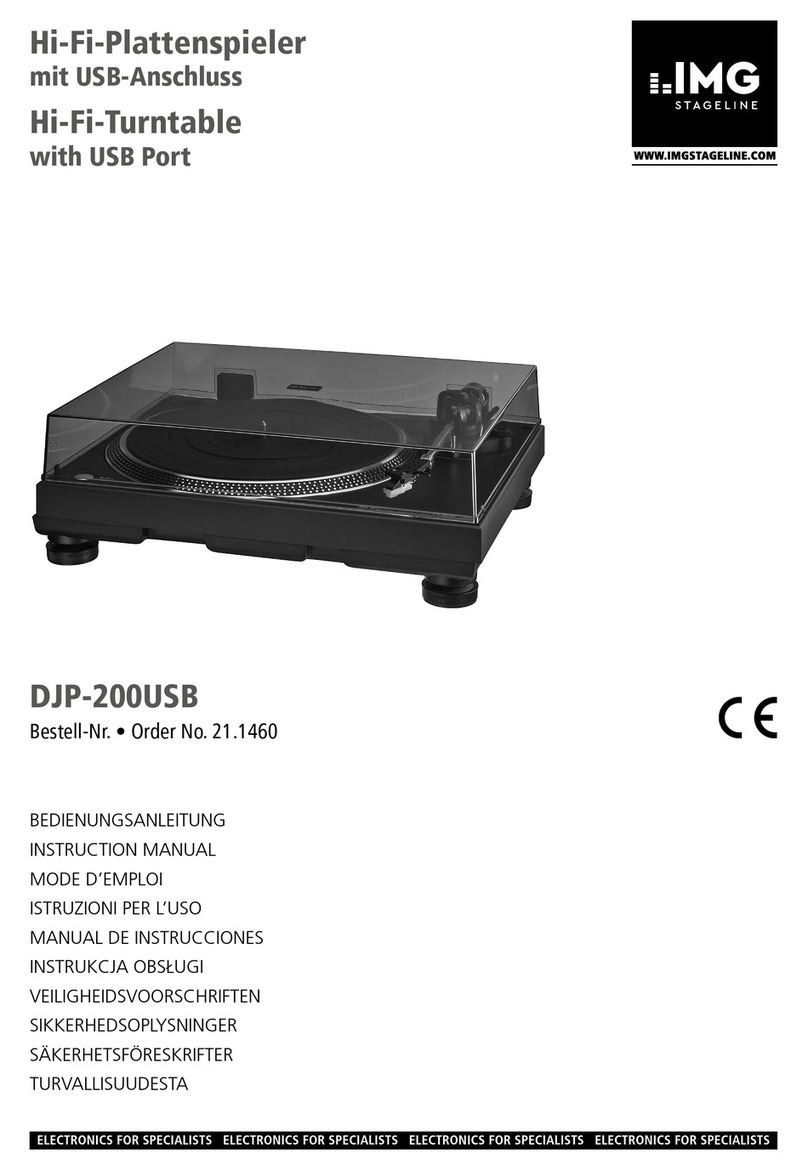
IMG STAGE LINE
IMG STAGE LINE DJP-200USB User manual
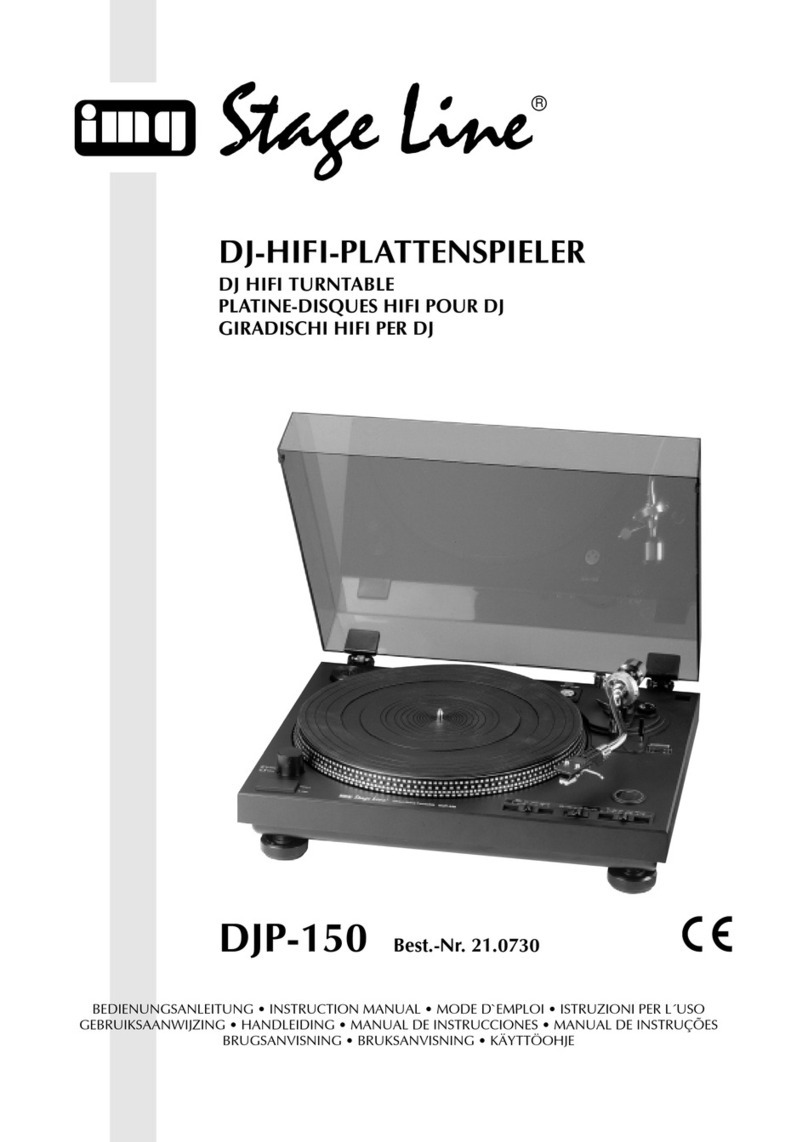
IMG STAGE LINE
IMG STAGE LINE DJP-150 User manual
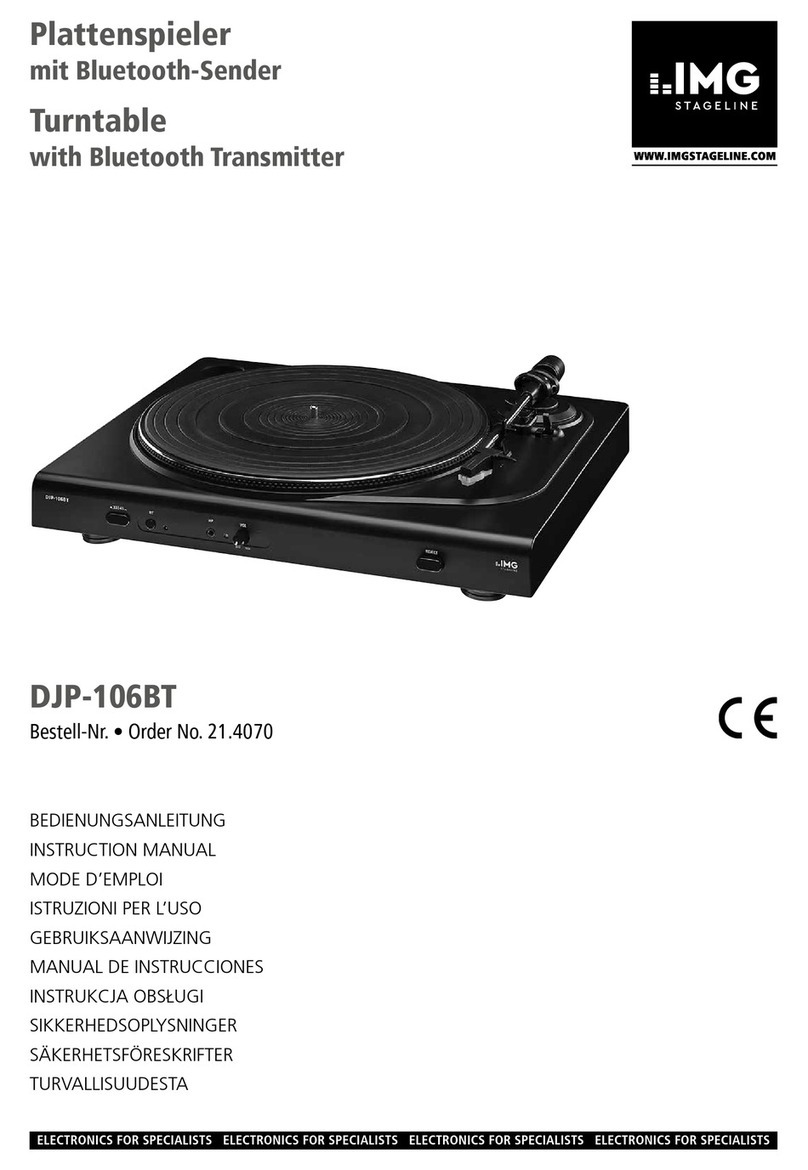
IMG STAGE LINE
IMG STAGE LINE DJP-106BT User manual

IMG STAGE LINE
IMG STAGE LINE DJP-122 User manual

IMG STAGE LINE
IMG STAGE LINE DJP-250/SI User manual
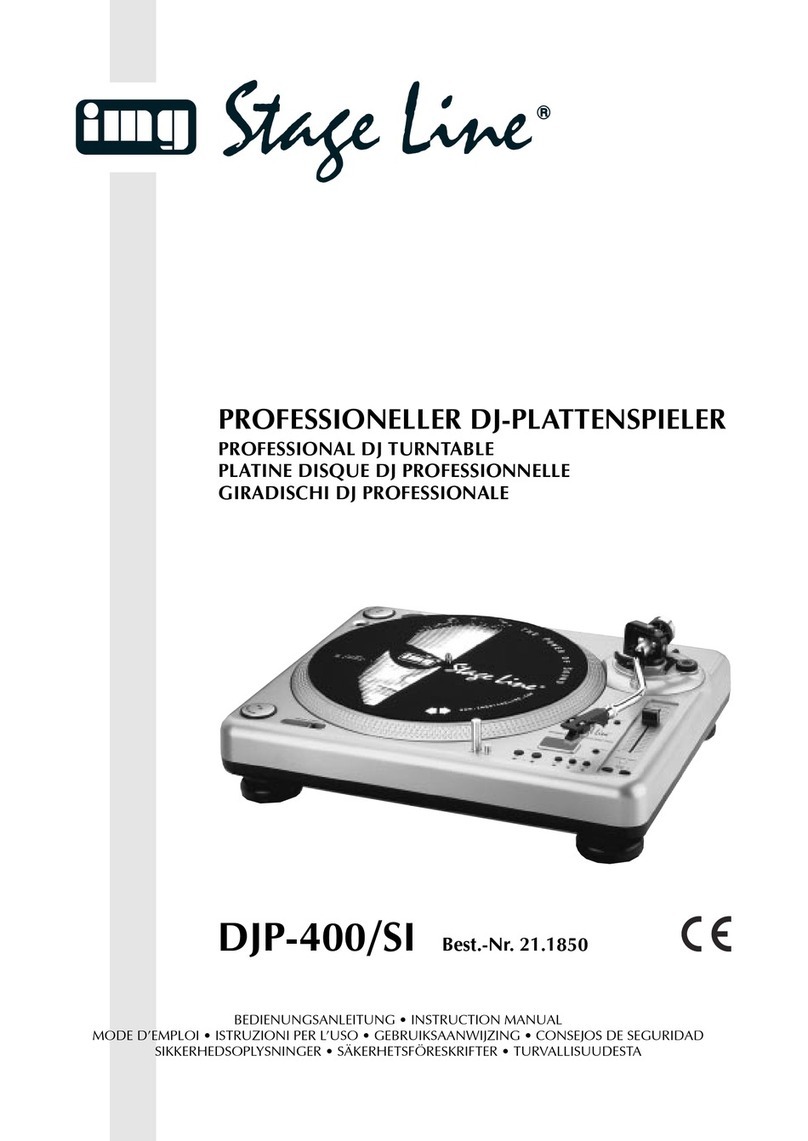
IMG STAGE LINE
IMG STAGE LINE DJP-400/SI User manual
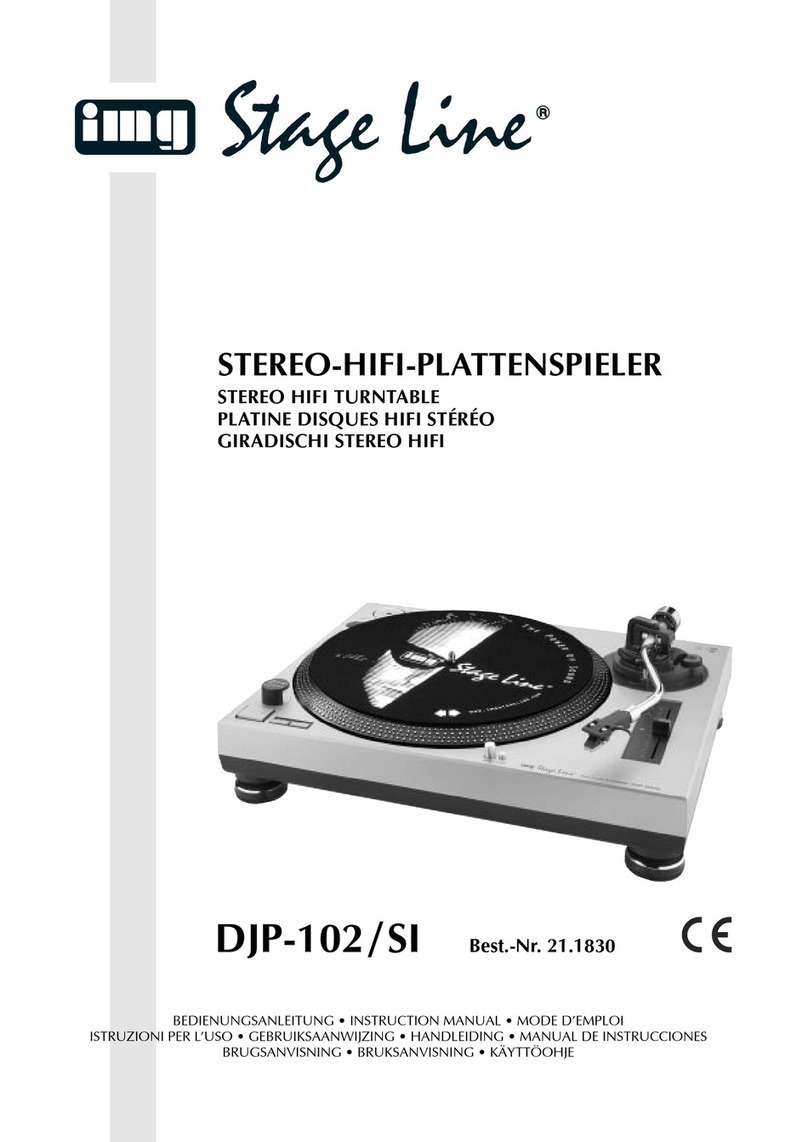
IMG STAGE LINE
IMG STAGE LINE DJP-102/SI User manual

IMG STAGE LINE
IMG STAGE LINE DJP-200 User manual

IMG STAGE LINE
IMG STAGE LINE DJP-106SD User manual
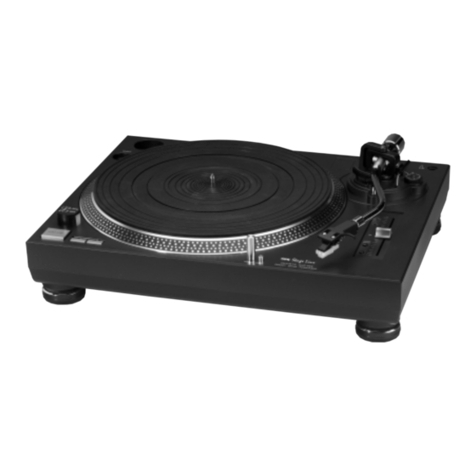
IMG STAGE LINE
IMG STAGE LINE DJP-202 User manual
